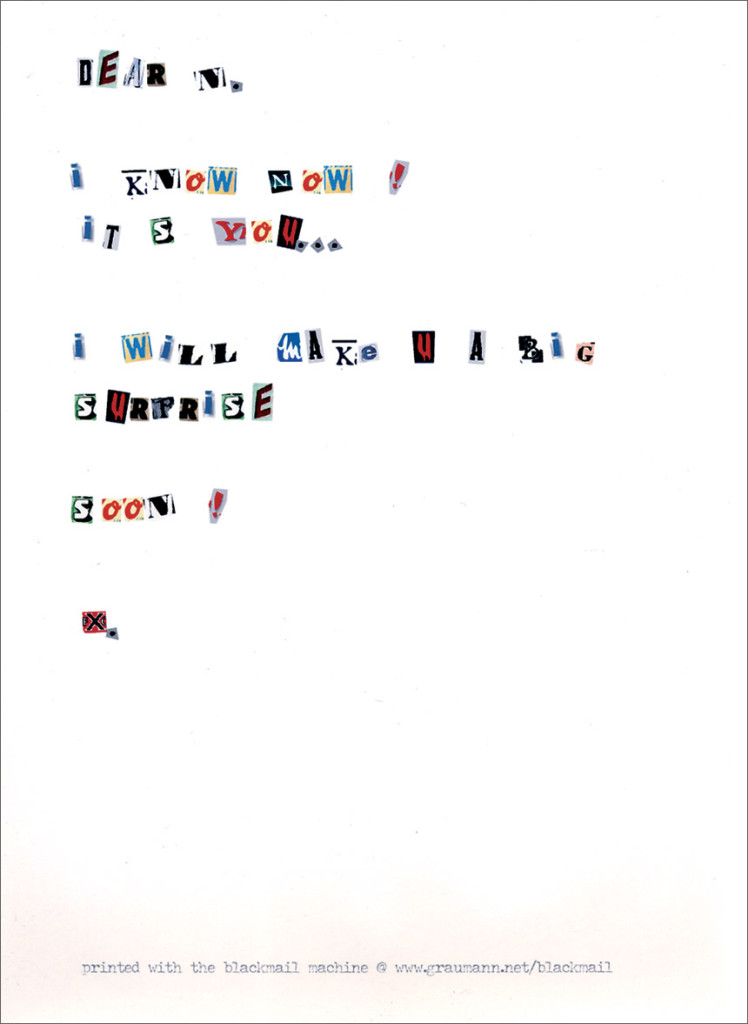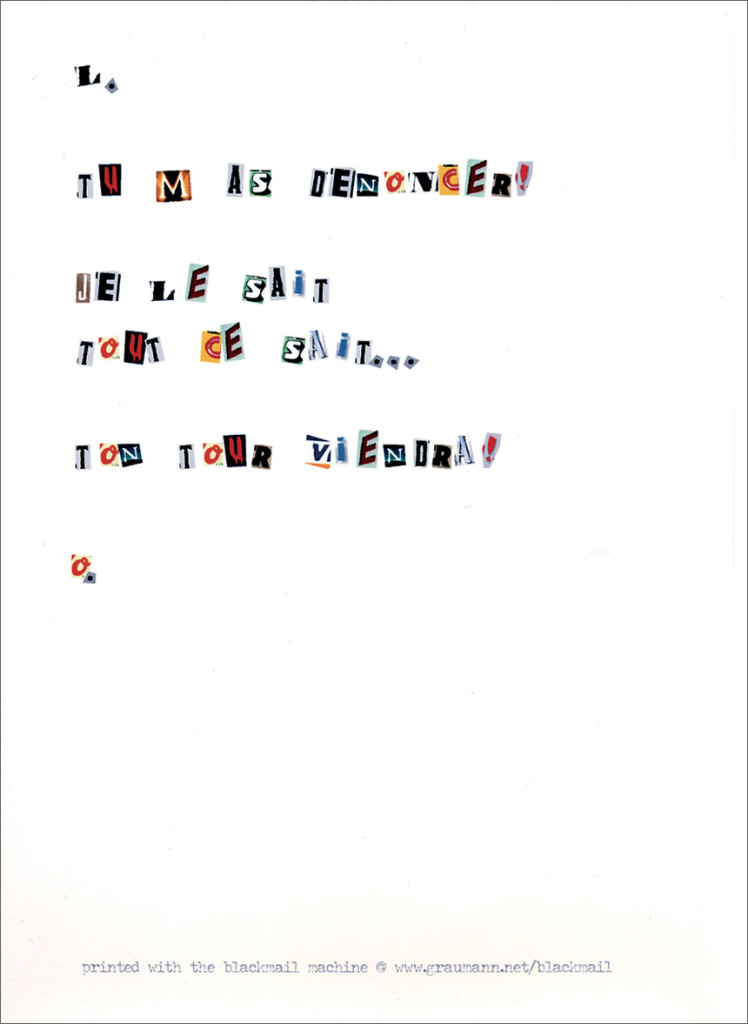vertical pattern square orange I
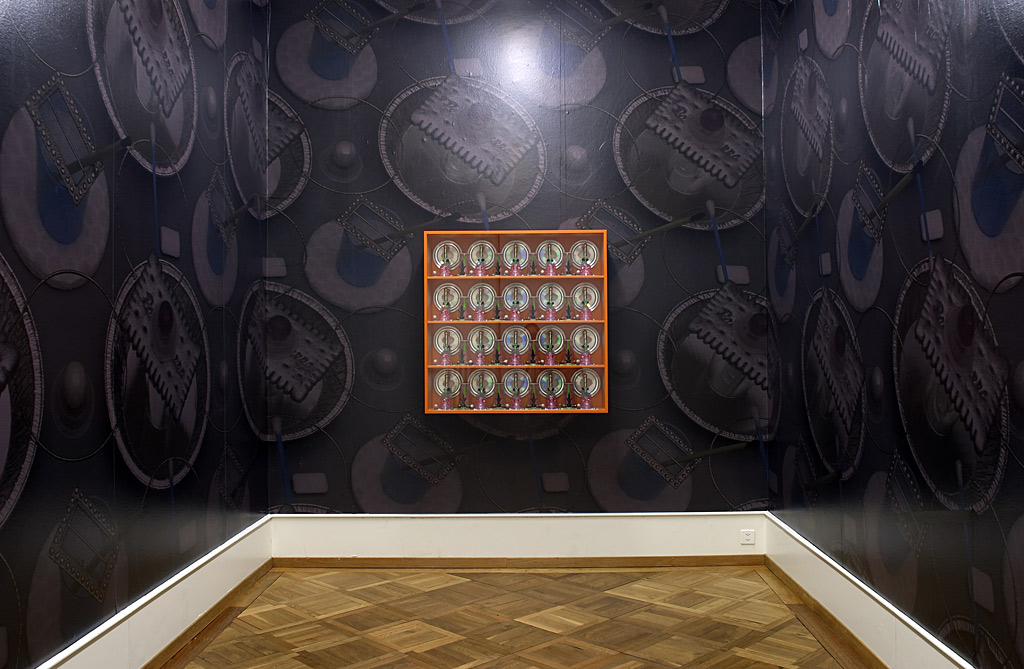
Vertical Pattern Square Orange, 2007 – view Centre Pasquart, Bienne (photo: Daniel Muller)

Vertical Pattern Square Orange, 2007 – view Centre Pasquart, Bienne (photo: Daniel Muller)
Hervé Graumann – Geneva – installations by the artist are on display at the Musee d’art moderne et contemporain
ArtForum, Sept, 2003 by Hans Rudolf Reust
That Raoul Pictor is a painter is obvious. Wearing a black beret and the white smock of his profession, he paces back and forth in his studio in search of inspiration, from the stool to the bookshelf to the table where a wineglass stands and then over to the easel. Wildly, he dunks a thick brush and begins to paint, accompanied by the sounds of splattering pigment. By the time he takes his masterpiece down from the easel and carries it off, we’ve still seen only the back of the canvas–and, indeed, we can only view the completed artwork by printing it out. With Raoul Pictor, Hervé Graumann has created a virtual painter who pursues the aura of the painted original via the random constellation of a computer-generated image. With the click of a mouse, our dear painter will paint as many pictures as we like. The auctorial gesture of painting serves to animate the black-box image production of the computer processor, which is ultimately invisible. The computer as artist, assuming it has an intelligence distinguishable from the designs of its programmers, wears every face and no face at all. So why not the one under the beret of a Montmartre painter?
At the exhibition in Geneva, this piece, Raoul Pictor cherche son style… (Raoul Pictor searches for his style…), 1993, could be navigated from the sofa in a small lounge, bringing a living-room mode of perception into the museum while ironizing the aesthetics of image consumption in the ’90s. L.o.s.t., 1997, Graumann’s piece for Documenta 10, was housed exclusively on the Web. In a luminous white circle controlled by the mouse, like the beam of a searching flashlight, fragments of a text appear–traces of language in the search for a network of lost existence, ending in an offer of contact with a cryptic e-mail address, perhaps that of the person lost. The blackened monitor screen becomes a metaphor for the dark, incomprehensible side of global connectedness.
In comparison, the installation of Pattern–Vanité 2b, 2003, which filled one of the bays at MAMCO such that it became inaccessible, seems easily comprehensible. Graumann worked for a time in the neuroscience and dermatology department at a hospital in Geneva, and here he created a sculpturally fantastic ensemble from the little objects one typically finds by a patient’s bed: Surrounded by the sweeping oval of a cannula, pill cups in primary colors are piled up along with a gleaming, silver-colored plastic plate topped with meringue; a CD shining in rainbow colors rests on a paper doily with an enormous nail that has pierced a tin-foil ball; on the very top of the plastic-cup tower is a little polystyrene skull with silver rays (in the form of pipe cleaners) beaming from its dark eye sockets, gleaming in the bright museum light. Next to this is a still life with a breakfast egg, a red rose, and a large syringe. The many elements of this nature morte alternate between the traditional meanings of a memento mori and the contemporary realities of high technology in medicine. On the floor, through the perfectly executed repetition of the same filigree, eighty times, a hallucinatory pattern emerges–threatening to reproduce endlessly and to absorb the entire world. The fascination of glittery Christmas decorations in a store display is combined here with the fear of the uncontrollable growth of one’s own cells.
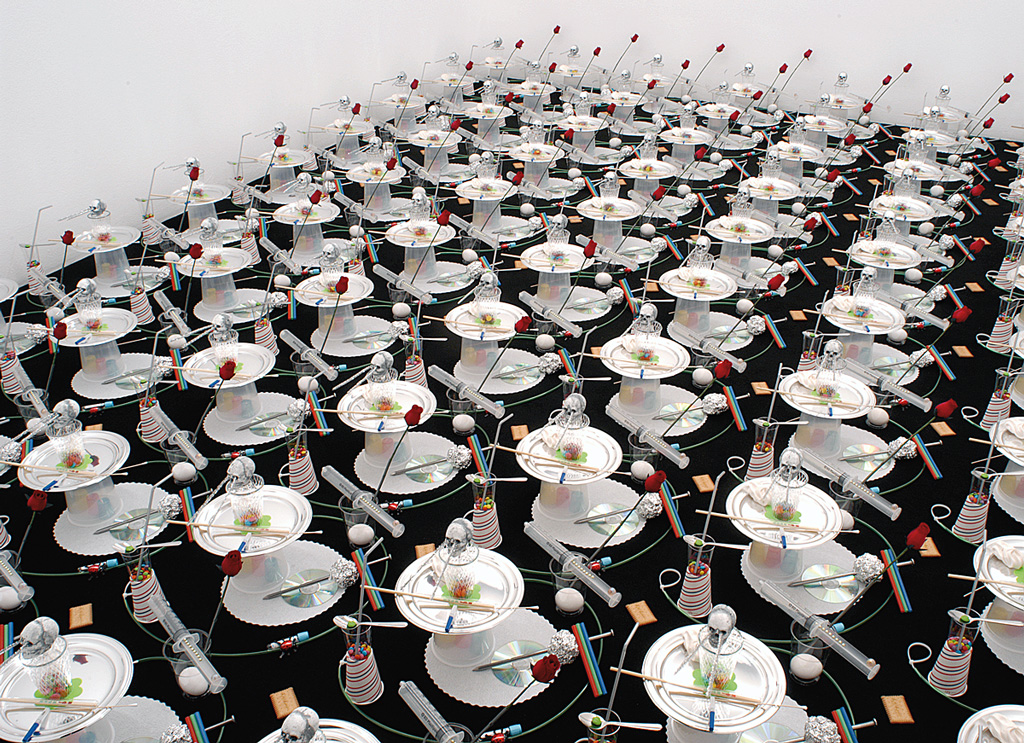
Pattern – Vanité 2b, 2003 – installation, objets divers / installation, sundry objects – 400 x 500 cm.
–Hans Rudolf Reust Translated from German by Sara Ogger.
© 2003 Artforum International Magazine, Inc.
© 2003 Gale Group
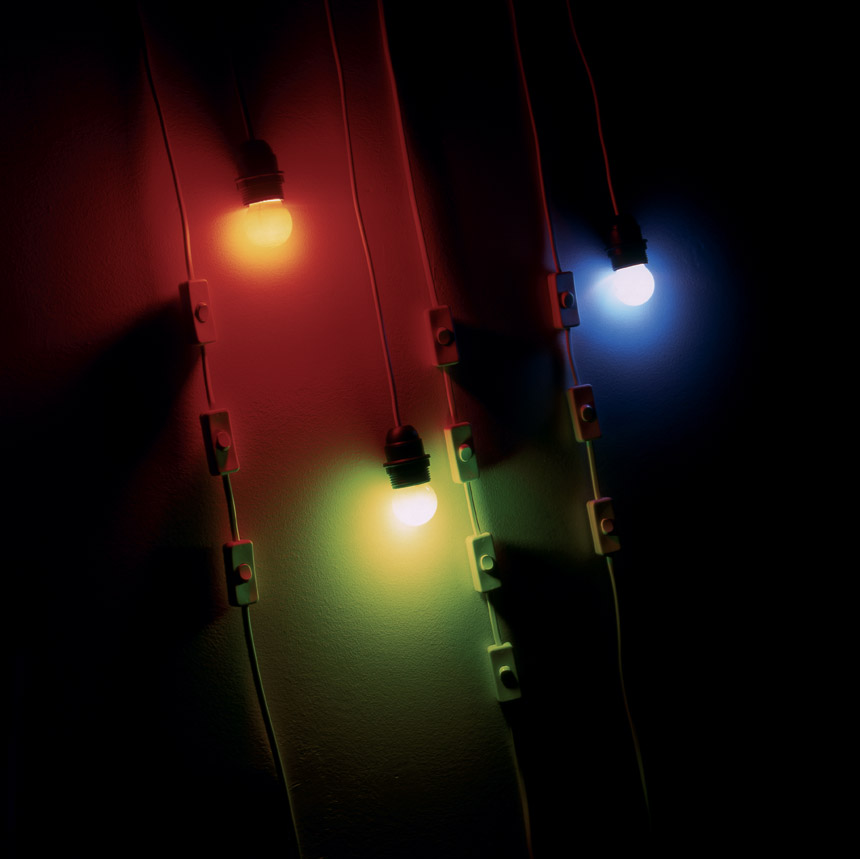
Lampes code RGB, 1998 – lampes, multiples interrupteurs / lamps, multiple switches – dimensions variables
Anyone who wants to illuminate Hervé Graumann’s lamp with its four switches in series must first solve a problem of Boolean algebra, as it applies to digital circuits. Each switch has two positions, 1 or 0, on or off. From the position of the switch – up or down (u/d) – you cannot tell with Graumann’s lamp whether the switch in question is allowing the current to flow or not. To produce light, every possible variation of switch combinations must therefore be worked through in a systematic way, to avoid unnecessary repetitions: d-u-u-u, d-d-u-u, d-u-d-u, d-u-u-d, d-d-d-u, d-u-d-d, d-d-u-d, u-d-u-u, etc. It may take a while. George Boole established his logical calculus in 1847.
Hervé Graumann (1963*) lives and works in Geneva. Since the middle of the 1990s he has been exploring aspects of digital aesthetics and culture in his work. In 1997 he participated in documenta X in Kassel with some of his early online works.
http://www.digital-art-collection.net/collection/collection_e.html
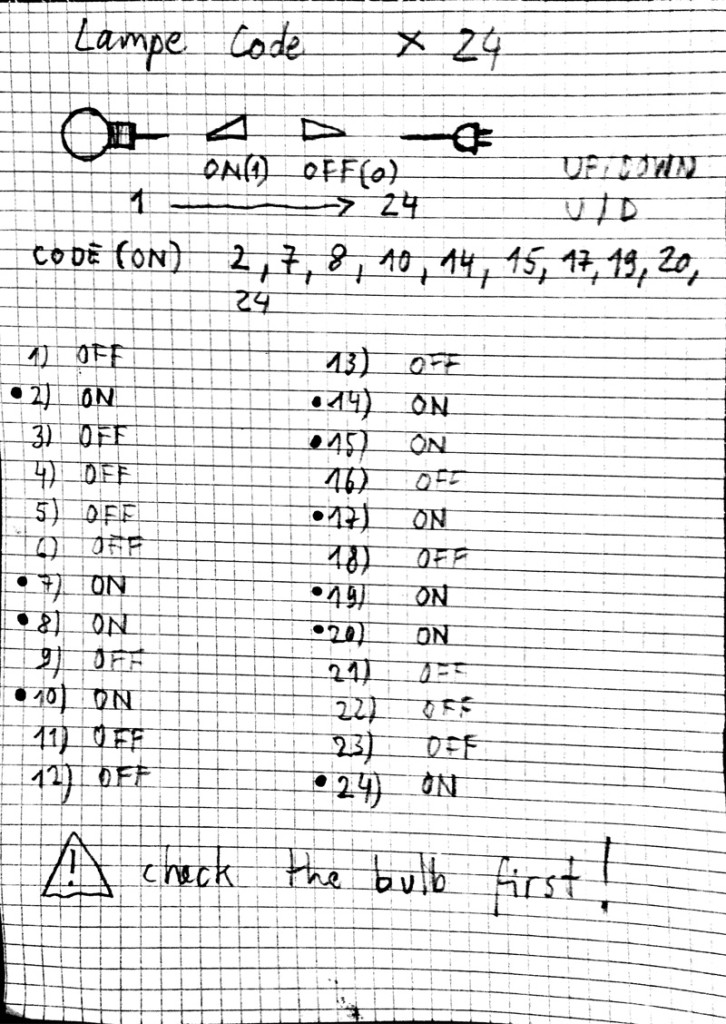
Lampe code 24, code sheet
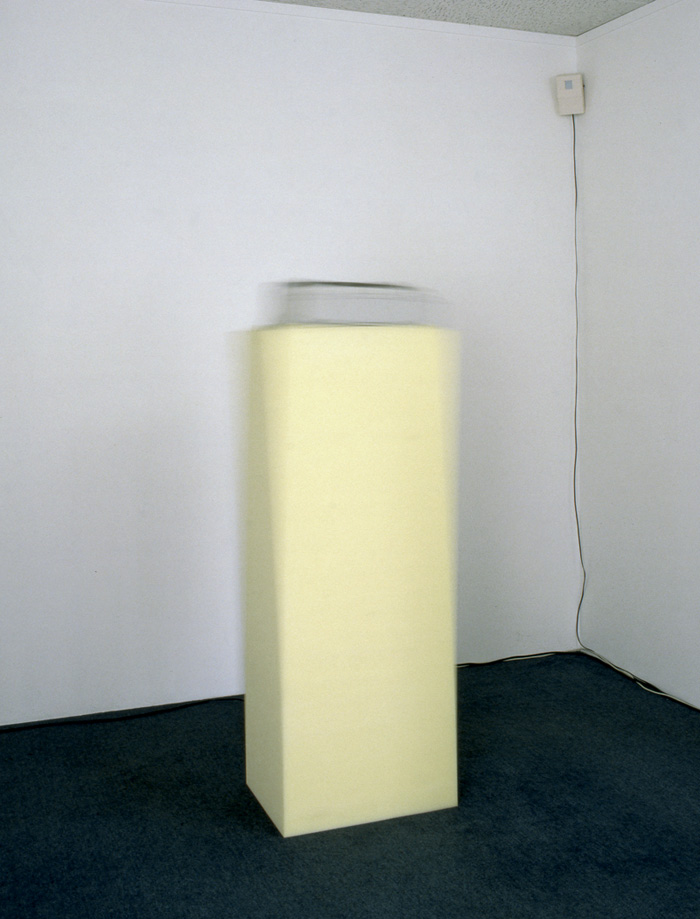
Hard on soft, 1993 – ordinateur, imprimante à aiguilles, socle en mousse / computer, dot matrix printer, foam base – 145 x 50 x 40 cm.
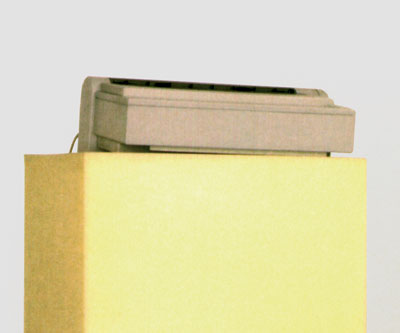
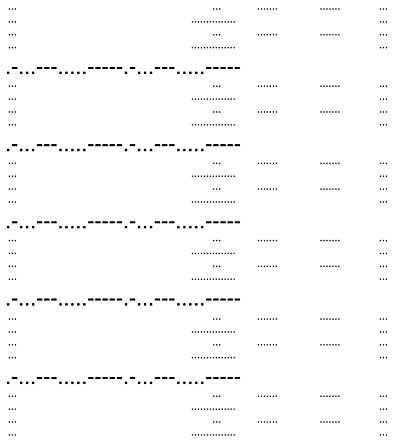
audio file of one of the 7 compositions
View: Andata Ritorno Gallery, Geneva, 1994
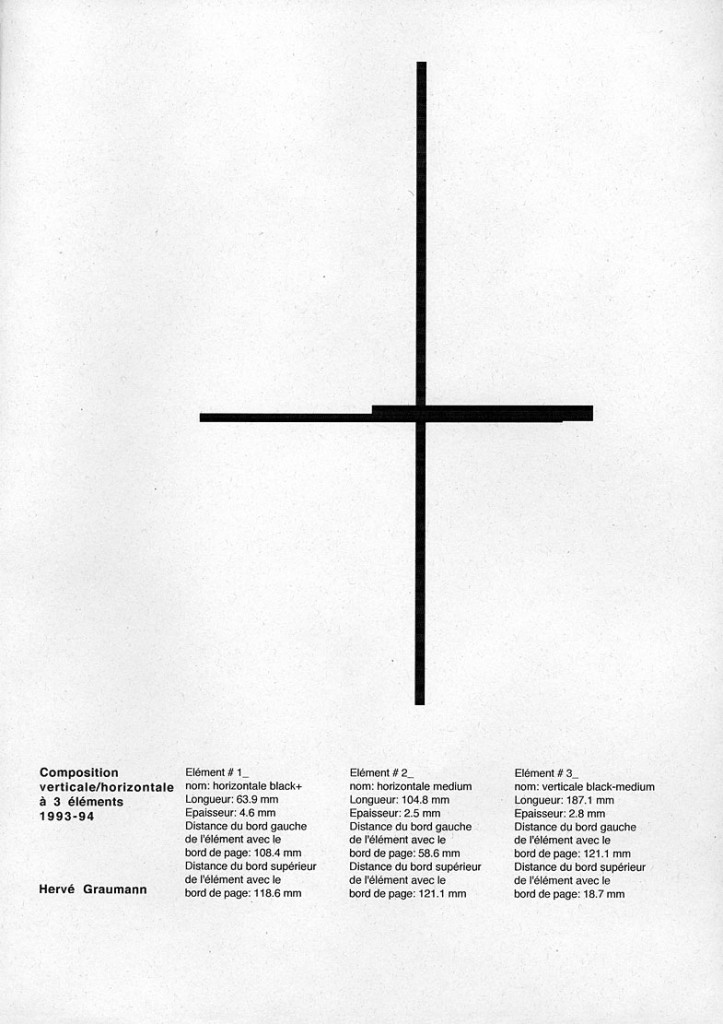
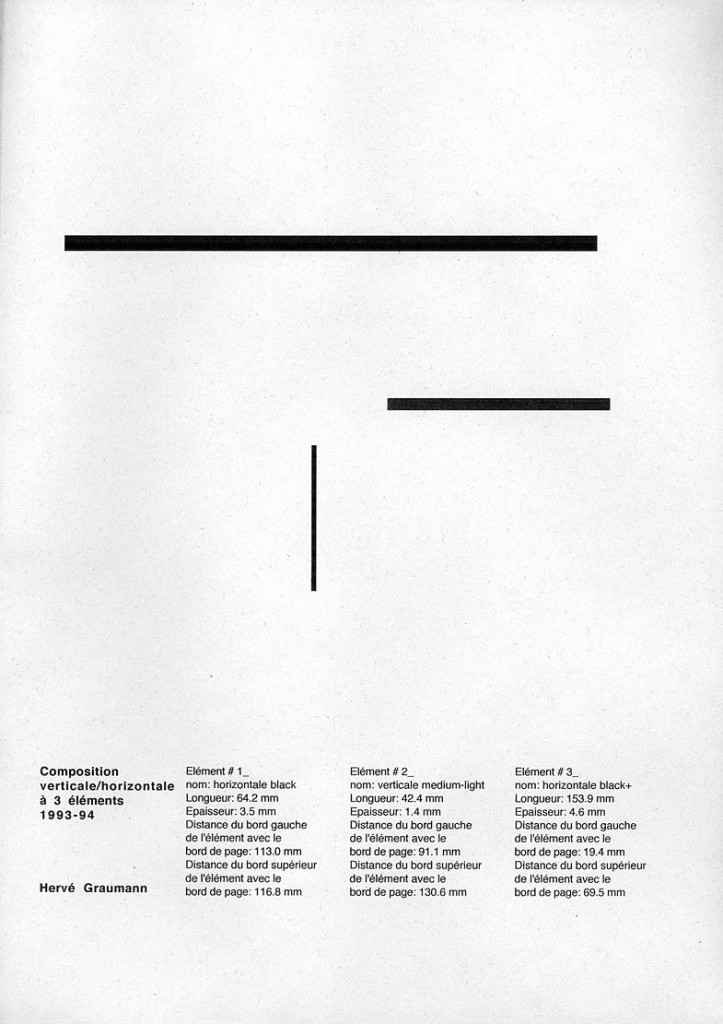
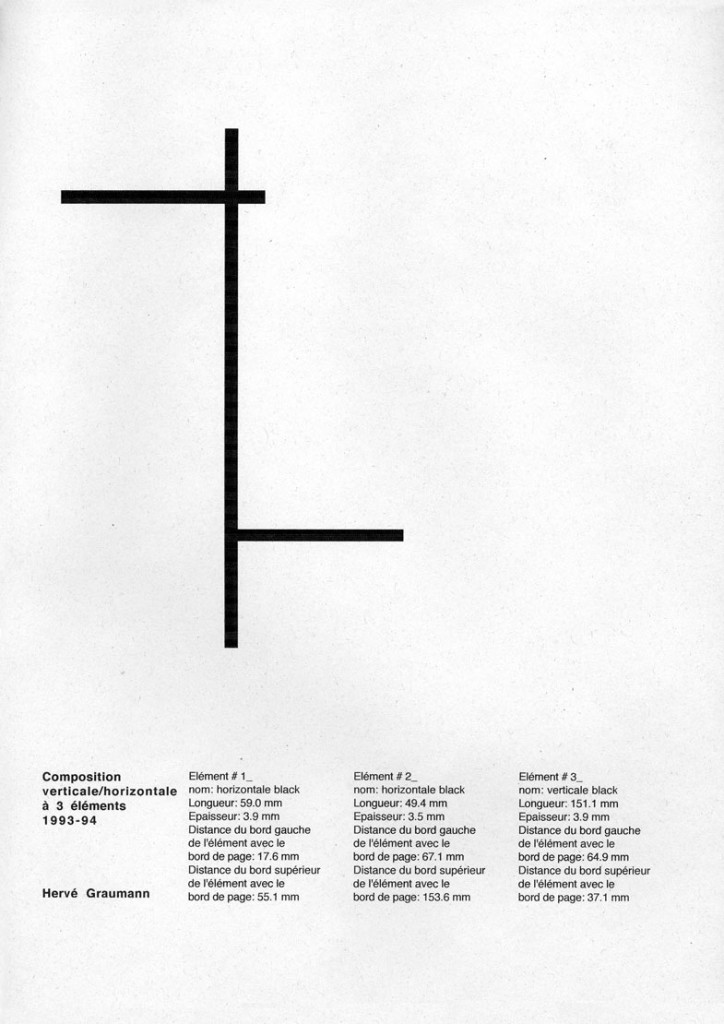
EZ models Videosculpture – Chalet II (Chamonix), 2005 – 3D Video 4’49”
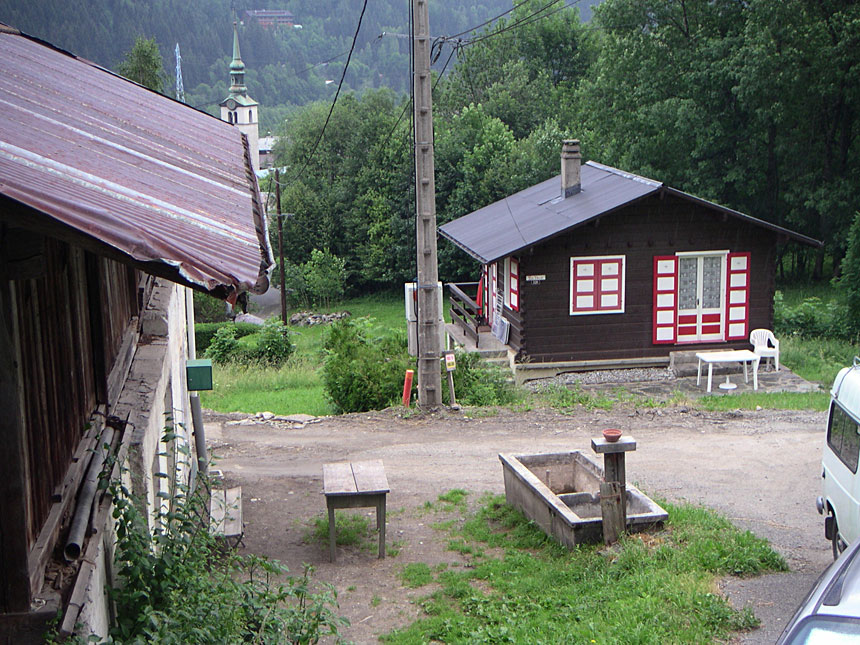
Original image used for the movie
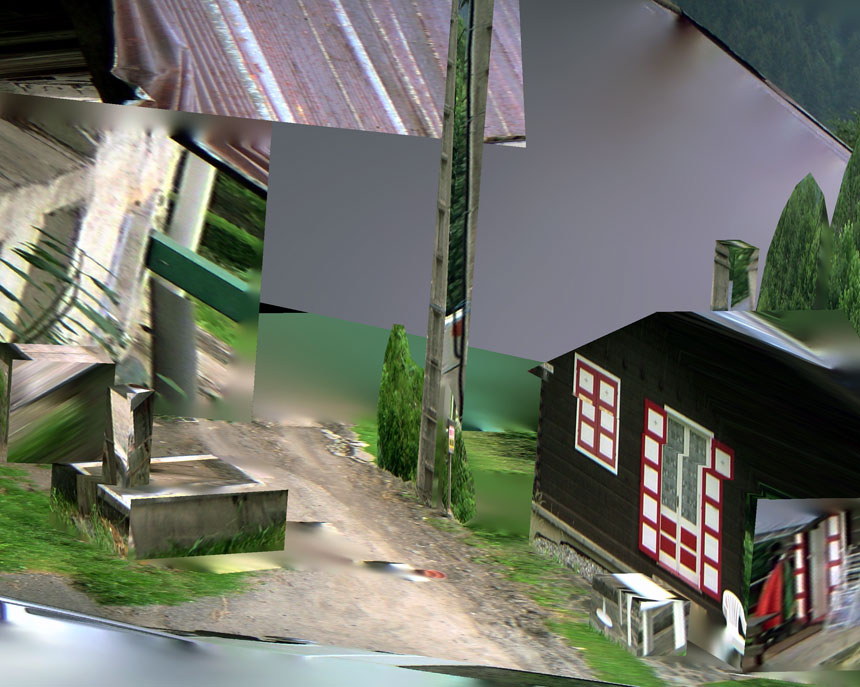
still from the video “EZ models / Videosculpture – Chalet II (Chamonix)”, 2005
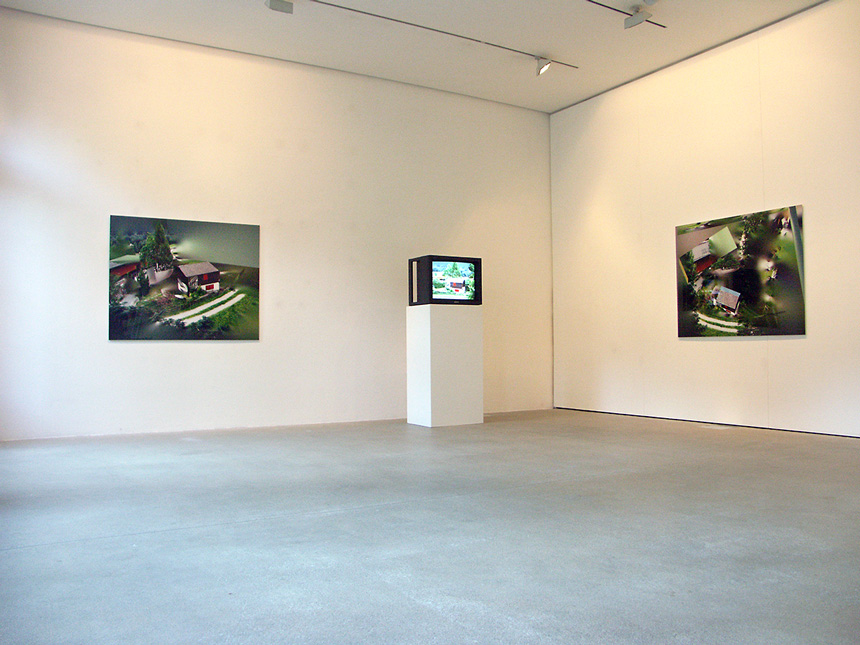
Exhibition view – Espace Arlaud, Lausanne
in cat Kairo Biennale 2006
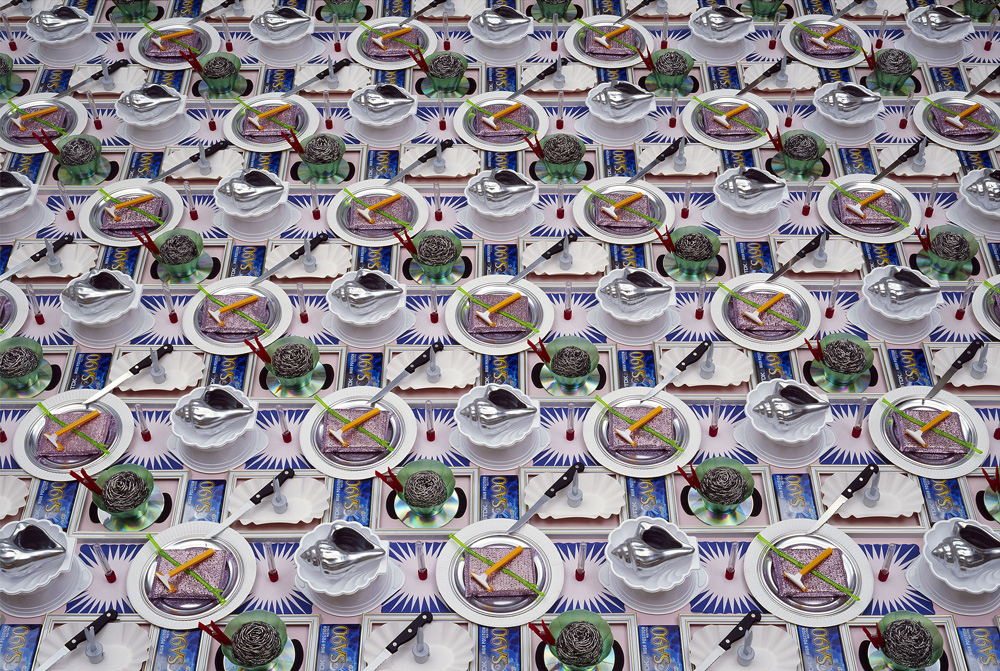
oriental carpet I, 2006 – endura print mounted on alu dibond – 180 x 258 cm.
Hervé Graumann zählte in den 1990er Jahren zu den Pionieren der digitalen Medienkunst in der Schweiz. Einem breiten Publikum bekannt wurde er 1993 mit der Arbeit “Raoul Pictor cherche son style…” (1993), die bis heute in leicht modernisierter Version auf dem Internet läuft (www.raoulpictor.com). In dieser Computeranimation können wir dem Maler Raoul Pictor – einem simplen Grafikmännchen aus der Generation des „Super Mario“ – dabei zuschauen, wie er ein Bild für uns malt. Das Gemälde sehen wir erst zum Schluss der ungefähr fünfminütigen Vorführung von vorne, wenn es aus dem Drucker kommt. Bis dahin verfolgen wir den mit allen Insignien des romantischen Klischees ausgestatteten Maler durch die Höhen und Tiefen des kreativen Prozesses: das Farbenmischen, die Konsultation der Literatur, das Delirium des Malaktes, die Trinkpausen usf. Zum Schluss steht das fertige Gemälde mit Signatur des Künstlers zum Ausdruck bereit. Sowohl der Ablauf dieses Prozesses wie auch das „Gemälde“ zu seinem Abschluss gestalten sich immer wieder neu, nach Massgabe des digitalen Zufallsgenerators.
Was auf den ersten Blick als amüsante Persiflage auf ein obsoletes Künstlerbild daherkommt, initiiert bei näherer Betrachtung eine Reflexion über die Bedingungen der Kunst und den Status des Künstlers im Zeitalter der digitalen Reproduktion. Auf der einen Seite haben wir den modernen Medienkünstler Hervé Graumann, der Programme schreibt, die Bilder generieren. Und wie bei der Computerlyrik stellt sich die Frage, was wir eigentlich in der Hand halten, wenn der Drucker ein „Gemälde“ ausspuckt: ein Kunstwerk von Hervé Graumann? von Raoul Pictor? oder gar keine Kunst? Auf der anderen Seite, in der digitalen Welt, das klassische Drehbuch des Künstlertums: Raoul Pictor mit Pinsel und Beret, im inneren Kampf mit dem „persönlichen Stil“, einmalig und authentisch, was der Maler zum Schluss mit seiner Signatur zum Gemälde bekräftigt. Ein schwer angegrautes Bild vom zeitgenössischen Künstler vielleicht, aber eines, das noch immer das Zentrum des Kunstbetriebes und seiner Ökonomie besetzt. Keiner der jungen Computer- oder Internetkünstler konnte sich bisher mit programmierten, beliebig reproduzierbaren Arbeiten im Olymp der Gegenwartskunst etablieren.
Ihren Witz und ihr kritisches Potential entwickeln viele von Hervé Graumanns Arbeiten über eine Um-Setzung, über eine Verschiebung von Elementen vom einen System in ein anderes. Bei dieser Um-Setzung werden auch gewisse Regeln in das neue System übernommen, die dort deplaziert wirken und gerade dadurch erkennbar sind. In den Videoskulpturen der „EZmodels“, den virtuellen Kamerafahrten durch computergenerierte Räume, setzt Hervé Graumann Fotografien mit Hilfe des Computers in den dreidimensionalen Raum um. Während der Vorgang in der Gegenrichtung, also bei der Verflachung des Raumes zur Fotografie, von uns ohne Mühe mental ausgeglichen und als originalgetreue Spiegelung einer Realität gelesen wird, bildet sich beim Aufblasen der Fotografien auf den Raum eine befremdende, unheimliche Welt, mit visuellen Leerstellen, die aufzeigen, was beim Fotografieren verloren ging. Dieselbe Befremdlichkeit eignet auch den virtuellen Welten der Computerspiele, aber es wird wohl nicht mehr lange dauern und wir fühlen uns in den Räumen der Videoskulpturen so heimisch wie im Ausstellungsraum. Dem Weg vom Raum zum Bild und zurück zum Raum entspricht der Medienwechsel von Natur zu Fotografie zu Video. Hervé Graumanns künstlerische Recherche gilt solchen Wechseln und ihren Folgen, mehr als dem Gebrauch der „Neuen Medien“ an und für sich.
Hervé Graumanns Arbeiten aus der Serie der “Pattern”, die er in Kairo zeigt, scheinen als ornamentale Zusammensetzungen und endlose Wiederholung eines einzelnen Motivs auf den ersten Blick ihren Titel zu bestätigen. Gerade in der Computerwelt haben solche Bildornamente in der Verwendung als „Wallpapers“ für Desktops und andere Sites ja wieder eine allgegenwärtige Präsenz erhalten. Graumanns „Patterns“ allerdings geben nur vor, solche zu sein. Sie sind nicht am Computer in der Ökonomie von “copy and paste” entstanden, sondern beruhen auf klassisch künstlerischem Handwerk: Hervé Graumann baut seine Kompositionen als räumliche Installationen auf und fotografiert sie zur weiteren Verwendung als gerahmtes Bild oder Tapete. So verbinden seine Patterns über die Medienwechsel die unterschiedlichen Genres mit den unterschiedlichen Gesetzmässigkeiten und Wertungen, die sie in der europäischen Kunsttradition mit sich tragen. Die synthetische Objektakkumulation der Installation – in einer Tradition von Pop Art und Nouveau Réalisme – überlagert sich mit dem mimetisch detailgetreuen, perspektivisch verkürzten Bildraum der Fotografie und der abstrakten Welt des Ornamentes mit seinen austarierten Farb- und Formkompositionen; je nach Standpunkt und kulturellem Hintergrund ein Weg von „low“ zu „high“ zu „low“. Und wie bei der Fabel oder der Travestie im Schauspiel erweist sich die eigentliche Konstitution der Figuren, wo sie in falschen Kleidern stecken. Aber auch die Macht der Kleider kommt erst richtig zur Geltung, wo sie die falschen Personen umhüllen.
Andreas Münch
in cat Cairo Biennial 2006
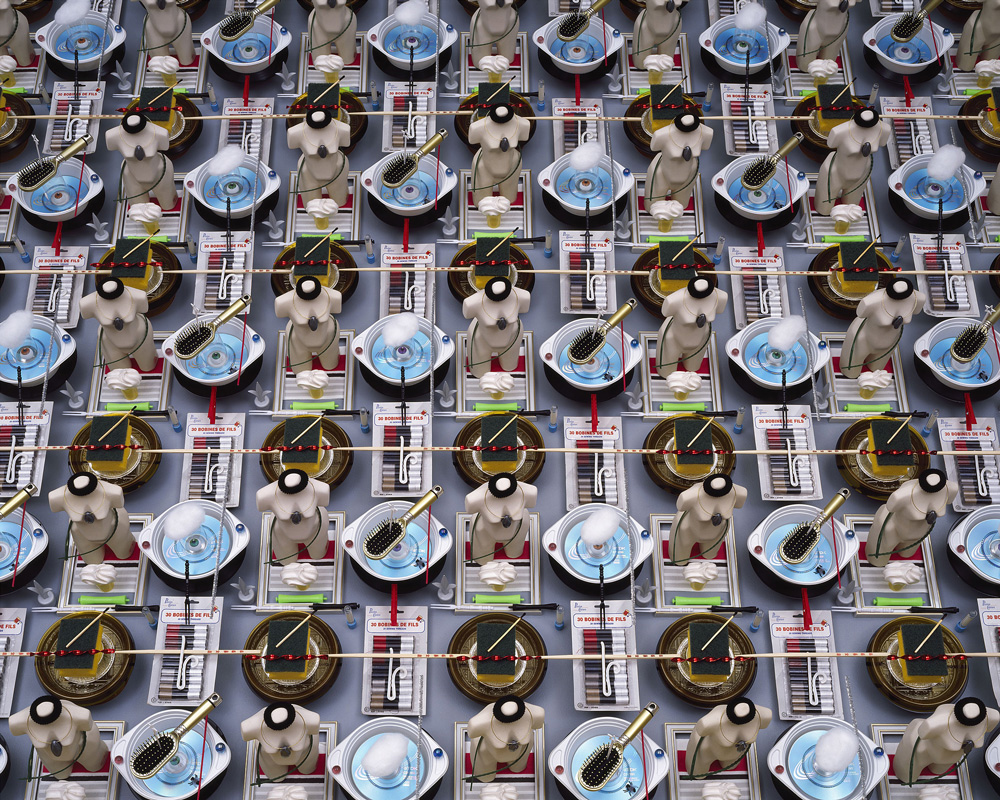
e-still life, 2006 – endura print mounted on alu dibond – 180 x 220 cm.
In the 1990s, Hervé Graumann was among the pioneers of digital media art in Switzerland. He became widely known in 1993 with his work “Raoul Pictor cherche son style…” (1993), a slightly modernized version of which is available on the Internet to this day (www.raoulpictor.com). In this computer animation, we can watch the artist Raoul Pictor – a simple little cartoon man of the generation of “Super Mario” – at work: he is painting a picture for us. It is only at the end of the roughly five-minute clip that we get a front view of the painting once we have printed it out. Until then, we follow the painter, who is represented with all the characteristics of the archetypal romantic artist, through the heights and depths of the creative process: he mixes colors, he consults works of literature, he experiences artistic ecstasy in the act of painting, he interrupts his work to take a drink etc. At the end, the finished painting bearing the signature of the artist is ready for print-out. Both the creative process and the printed “painting” are different every time due to the digital random generator used for the animation.
On the face of it, Graumann’s animation appears to be an amusing persiflage on an obsolete image of the artist. Upon closer contemplation, however, it calls for some reflection on the condition of art and the status of the artist in the era of digital reproduction. On the one hand, we have modern new media artist Hervé Graumann who writes programs that in turn generate pictures. As is the case with computer lyrics, the question arises what we are actually holding in our hand when the printer spits out a “painting”: is it a work of art by Hervé Graumann? by Raoul Pictor? or no art at all? On the other hand, the digital world presents us with the classic view of artistic genius: Raoul Pictor with his brush and his beret fighting an inner battle to find his own “personal style”, unique and authentic, qualities that the artist substantiates by putting his signature on the paintings. A rather outmoded image of the contemporary artist perhaps, yet one that is still at the heart of the world of art and its economic structures. At least none of the young computer and Internet artists has so far succeeded in establishing himself on the Mount Olympus of contemporary art with programmed works that can be reproduced in any quantity.
The characteristic wit and critical potential of many of Hervé Graumann’s works is based on a process of a transformation and dislocation whereby elements are displaced from one system to another. As part of this dislocation, certain rules from the old system are retained in the new one, and it is for the very fact that they seem out of place there that they become noticeable. In the video sculptures “EZmodels”, virtual rides through computer-generated rooms, Hervé Graumann uses a computer to convert photographs into three-dimensional objects. Whereas mental adjustments are easily made for the opposite process of flattening space to create a photograph the resultant products being read as a faithful replica of reality, the conversion of photographs into three-dimensional structures gives rise to a disconcerting and uncanny world with visual blanks revealing all that was lost when the photographs were made in the first place. The same disconcerting quality can still be detected in the virtual worlds of computer games, though it will probably not be long before we feel at home as much in the space of the video sculptures as we do in the showroom. The path from space to picture and back to space corresponds to the media change from nature to photography and from there to video. Hervé Graumann’s artistic research focuses on such media changes and their implications rather than the actual use of the “new media”.
At first sight, Hervé Graumann’s works from the series of “Patterns” which he shows in Cairo seem to represent what their title suggests: ornamental compositions with an endless repetition of a single motif. After all, it is precisely in the world of computers that such visual ornaments have once again attained a ubiquitous presence in the form of wallpapers for desktops and other sites. That said, Graumann’s “Patterns” only pretend to do justice to their name, for they were not created on the computer, in the economic spirit of “copy and paste”. Instead, they are based on traditional artistic handicraft: Hervé Graumann builds his compositions as spatial installations and subsequently photographs them for further use as a framed picture or wallpaper. Thus on the basis of various media changes, his patterns unite different genres characterized, in the European tradition, by different rules and valuations. The synthetic object accumulation of the installation – in the tradition of Pop Art and Nouveau Réalisme – overlaps with the mimetic details of the perspectively shortened pictorial space of photography and also with the abstract world of the ornament with its balanced color and form compositions. Depending on point of view and cultural background, this interaction of various visual elements can be seen as a path from “low” to “high” and back to “low”. Akin to fables and travesty as a theatrical device, the real nature of the figures is revealed when they are dressed in fake clothes. But even the power of clothes only fully manifests itself when they are worn by fake figures.
Andreas Münch

Green plant entertainment, 1994-95 – dispositif informatique, interface, logiciel, son, eau, lumière, plante verte computer device, interface, software, sound, water, light, pot plant – dimensions variables
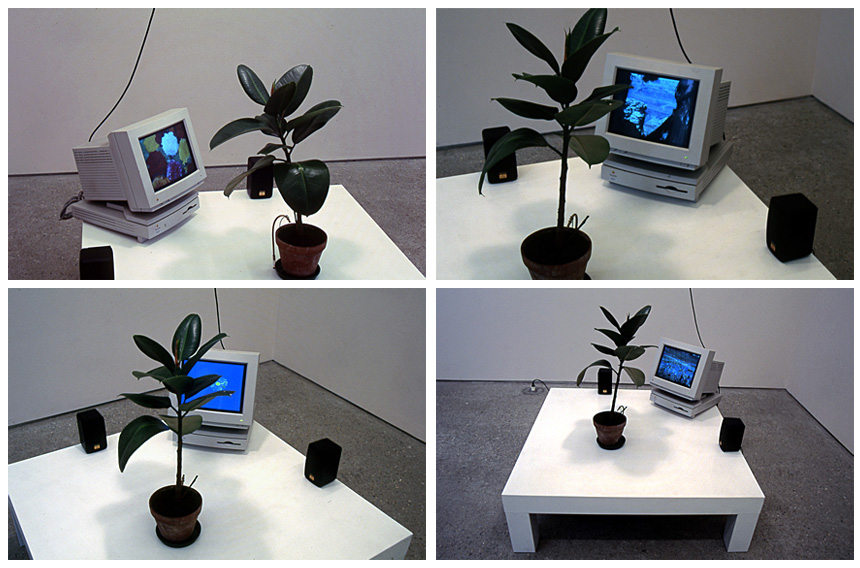
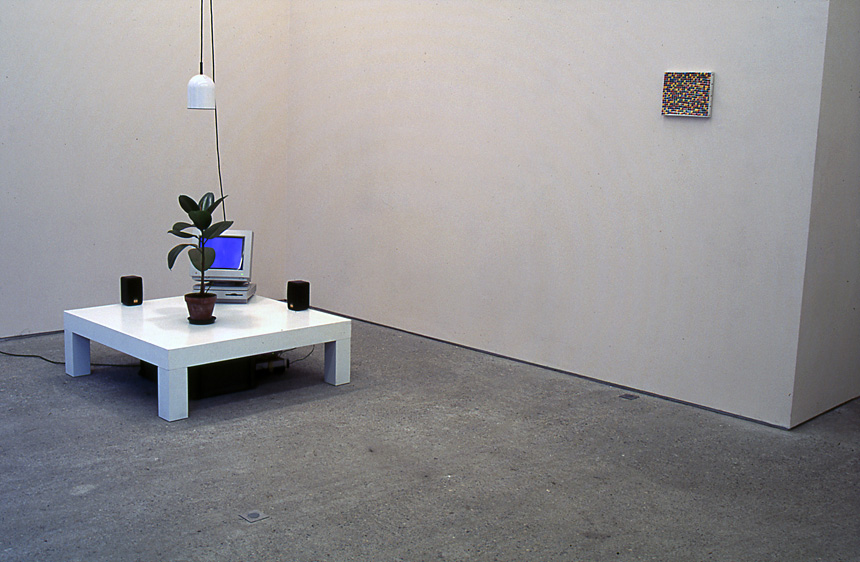

Exhibition view – “White noise”, Kunsthalle Bern, 1998
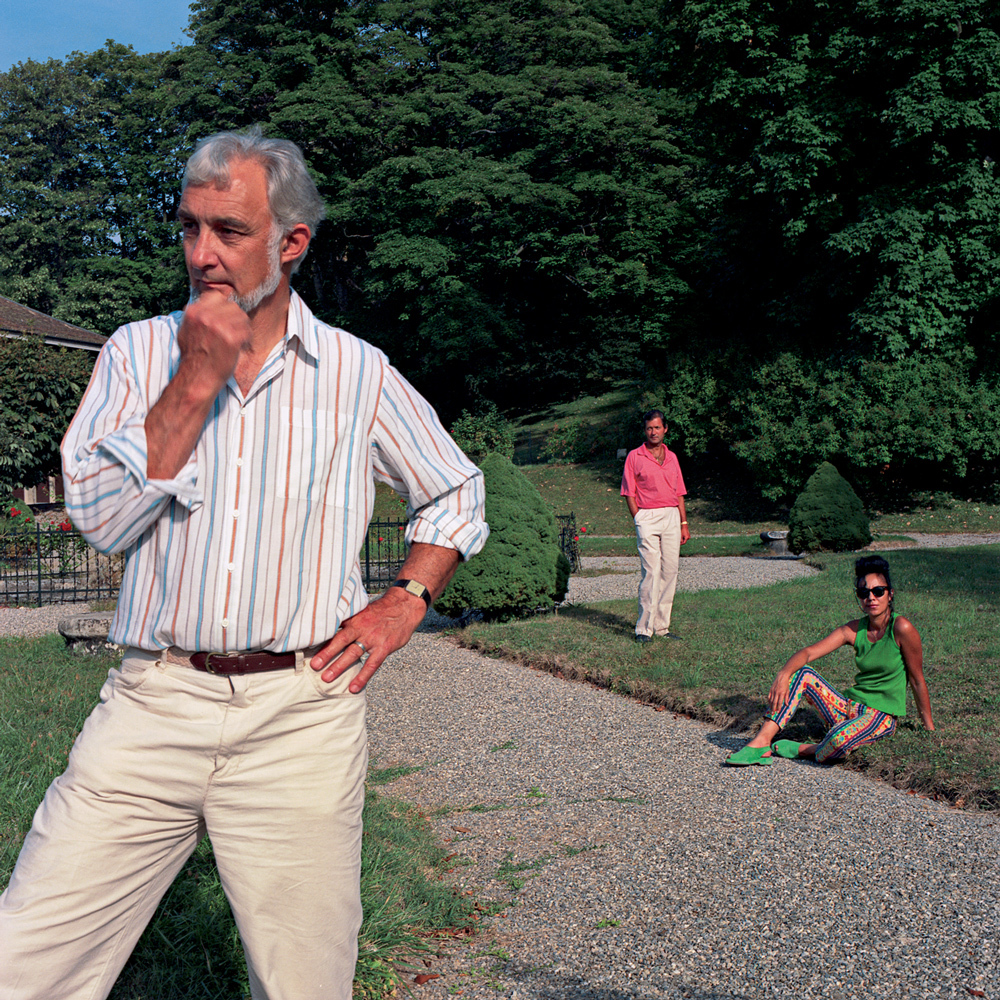
Buisson, Branche & Rossignol, 1993 – Avec MM. Jean-Paul Buisson, Gérard Branche & Mme Patricia Rossignol | color photograph – 125×125 cm.
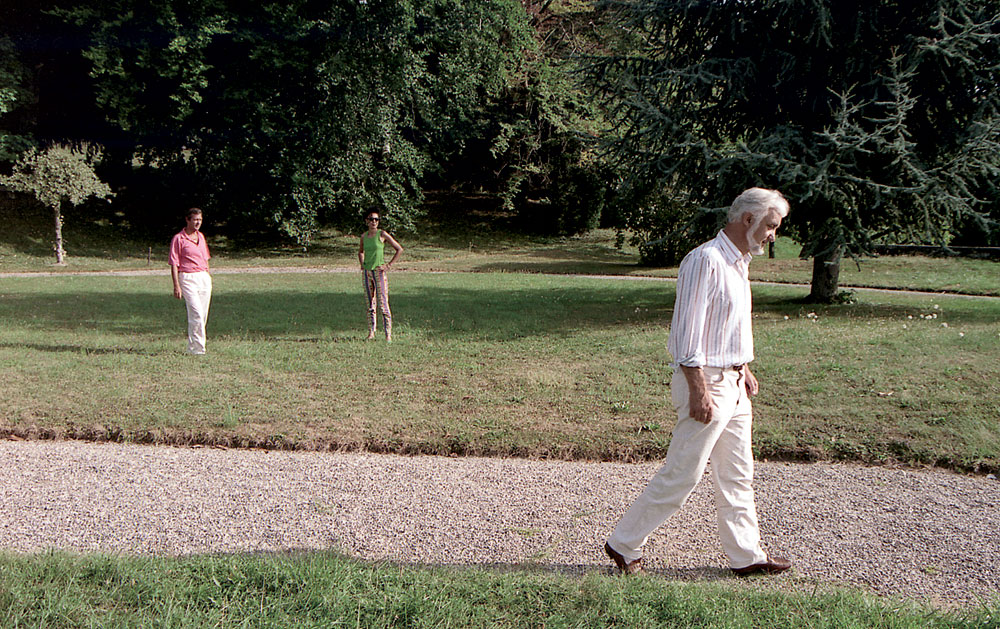
Buisson, Branche & Rossignol, 1993 – photographie couleur / colour photograph
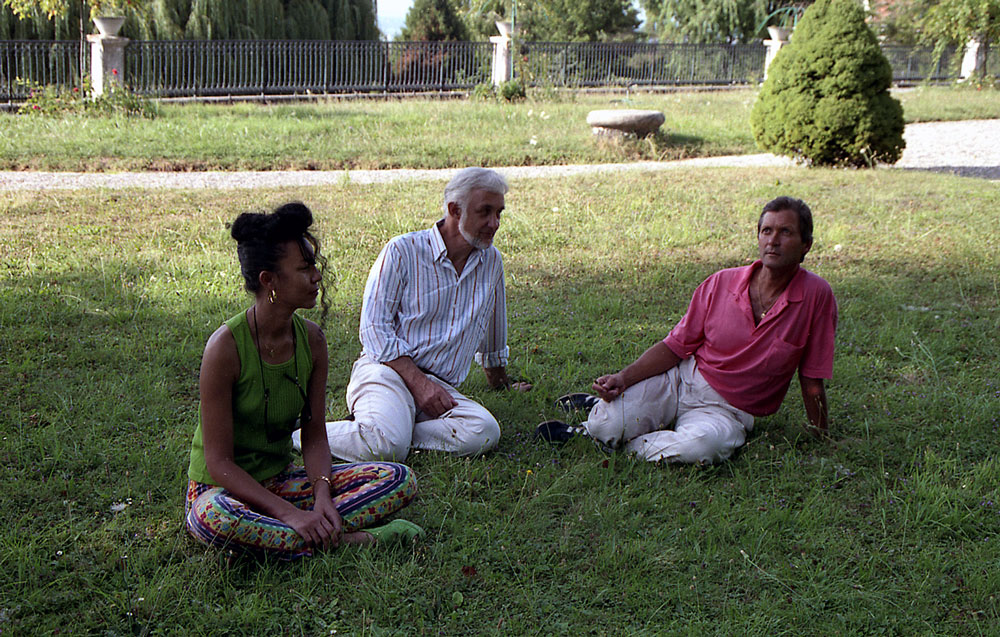
Buisson, Branche & Rossignol, 1993 – photographie couleur / colour photograph
“(…) Est-ce un hasard si cet artiste suisse romand s’est aperçu un jour qu’on lui avait imputé un faux nom de code de par ses origines, en contradiction avec sa langue maternelle? Peut-être est-ce cette étrangeté ou seulement même le manque de couleur de son nom (»Graumann« signifie en allemand »homme gris«), qui l’ont incité à entrer en rapport avec des personnages plus colorés, tels que Monsieur Brun ou la famille Rouge, et pourquoi pas aussi avec des personnes sans couleur comme les représentant(e)s des Schwarz (noirs) et des Blancs. Ne pourrait-on imaginer de créer un réseau artificiel de relations selon cette logique, et de passer par exemple des vacances au bord de la Mer Rouge ou sur le Fleuve Bleu, ou d’aller à Orange? Du coup, pinceaux et couleurs sont superflus, et l’art reste très proche de la vie. Dans sa démarche ludique, Hervé Graumann a poursuivi depuis longtemps sa voie, il est parvenu à réunir Monsieur Buisson, Monsieur Branche et Madame Rossignol pour une photo officielle. De même, avec les signatures de Madame Wolke (Nuage) et de Monsieur Stern (Étoile) ainsi que d’autres personnes, de belles compositions paysagères ont fini par naître sur la toile. Hervé Graumann ne saurait se cantonner dans l’art des ordinateurs et d’Internet, il entretient un contact insouciant et gai avec le pinceau et les pixels, avec le soft et le hard, faisant ainsi exploser les limites de la réalité et de la virtualité. Il tente d’utiliser l’art pour dévoiler plaisamment la juxtaposition, la superposition et l’interpénétration de noms, de couches de signes, de symboles et d’images sans recourir à une explication. (…)
-> Andreas Meier in “Nonchalance” (texte complet)
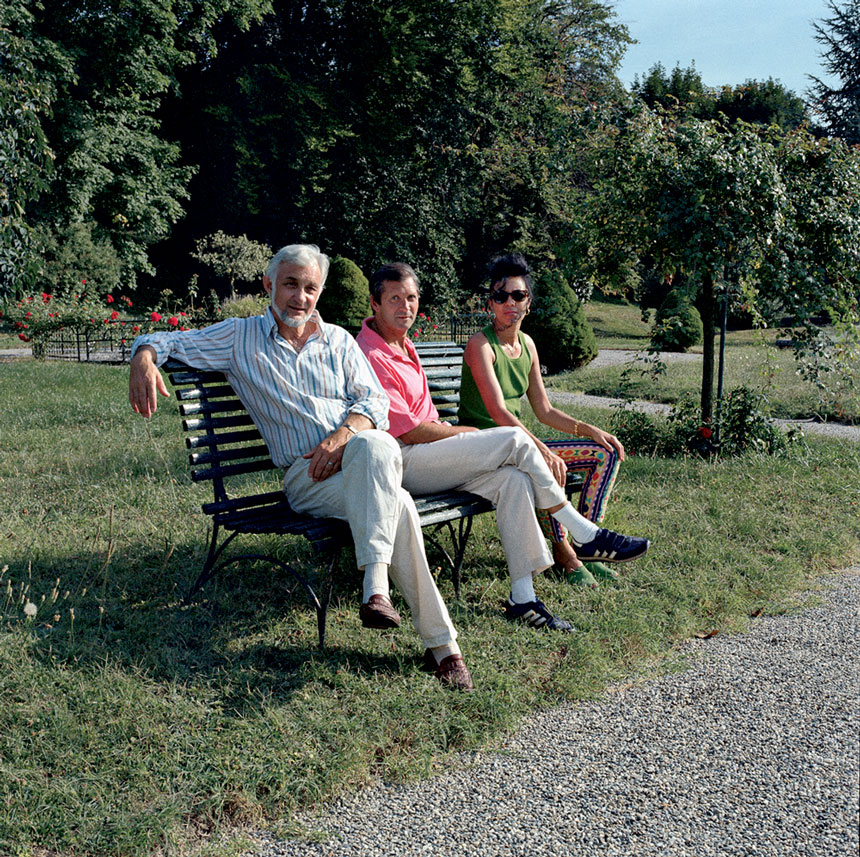
Buisson, Branche & Rossignol, 1993 – (Avec MM. Jean-Paul Buisson, Gérard Branche & Mme Patricia Rossignol) – colour photograph – 100 x 100 cm.

Séance de signature pour la Composition paysagère no 1, 1993
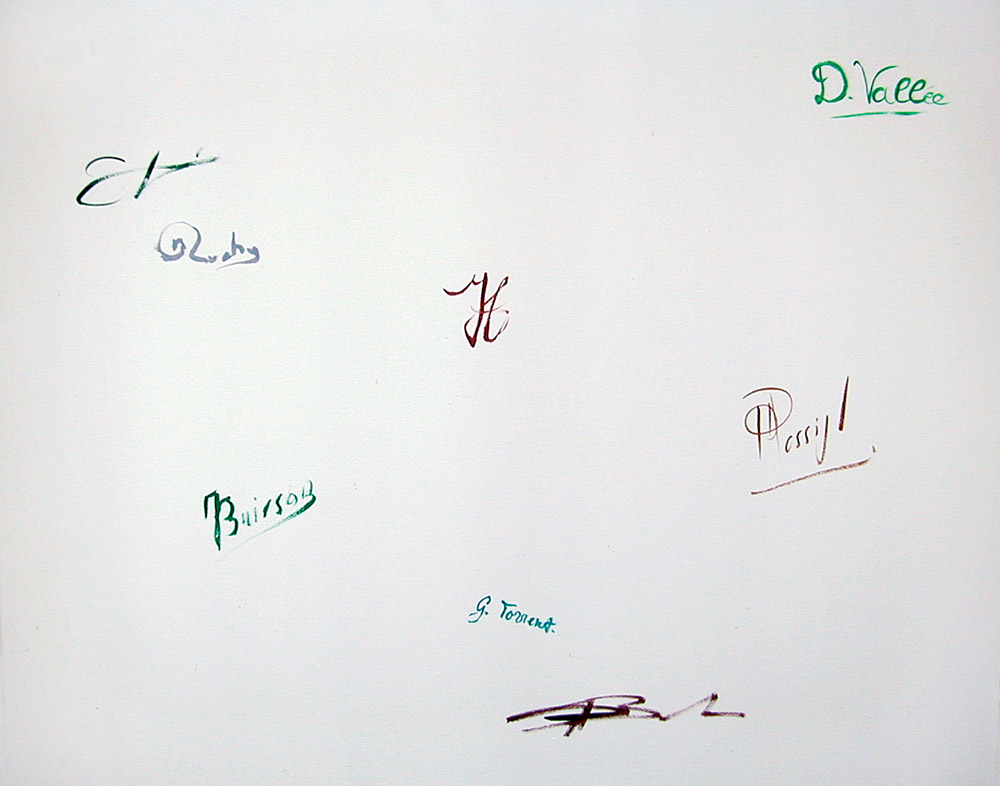
Composition paysagère no I, 1993 – Signatures de Dominique Vallée, Marc Sapin, Bernard Roche, Louis Hameau, Patricia Rossignol, Jean-Paul Buisson, Gilles Torrent & Gérard Branche – acrylique sur toile / acrylic on canvas – 72 x 90 cm.
—
> compositions française sur toile
Ich glaube nicht, dass sich Hervé Graumann besonders für die Farbe interessiert – so wie er sich auch nicht für die Verpackungs-Kartons interessiert, die er photographiert, oder für die Möbel, die er auseinandersägt. Ihm macht es Spass – gewiss ist er einer der seltenen Künstler, die sich heute amüsieren können -, aus einer nicht etwa beliebigen, sondern gleichgültigen Vorgabe eine Logik zu entwickeln. Was meine ich damit?
Erstens: Die Objekte oder die den meisten Arbeiten als Grundlage dienenden Objektqualitäten sind gleichgültig darum, weil kein signifikanter Inhalt aus ihrer Auswahl erwächst. Ich stelle mir vor, dass vielmehr ihre Umgänglichkeit, die Bequemlichkeit, mit der sie der Künstler manipulieren kann, das wichtigste Auswahlkriterium darstellt.
Zweitens: Trotzdem halte ich daran fest, dass diese Auswahl nicht beliebig ist, weil eine bestimmte Erfahrung der Welt durch den Eingriff des Künstlers umkippen kann. Das Objekt oder seine Erscheinung kann in einer Informationskette – oder treffender: in einem Informationsnetz – virtuell rekonstruiert werden. Die Härte des Steins ist dann nicht mehr eine Qualität eines bestimmten Steinblocks; sie kann davon gelöst werden, wie die Farbe, die Höhe, die körnige Struktur, die Masse usw. Der Glanz der Sonne ist dann provisorisch, gefiltert und kann plötzlich geregelt werden wie das Licht eines Theaterprojektors.
Drittens: Die Logik des Künstlers ist eine sachliche Auseinander-setzung mit der Logik der Information, so wie sie uns langsam durch unsere wachsende Vertrautheit mit dem Computer bewusst wird. Eine Logik der Erfassung, dann der Verarbeitung der Informationen.
Ich glaube nicht, dass man die Dinge mit einem Computer anders ausdrückt; nur der Ton ist neu; der Akzent hat sich verschoben. Wie kann man diese Verschiebung abmessen? Vielleicht ist genau das die Frage, die sich hinter der Arbeit Graumanns versteckt… Das wirklich packendste Merkmal ist das Fehlen einer Welt, d. h. einer Gesamtheit von festen Beziehungen zwischen den Elementen, aus denen die Dinge bestehen, und zwischen den Dingen selbst. Warum sollte man mit der Farbe Schluss machen? Weil die Maschine damit schon lange Schluss gemacht hat, unter anderem? Das will noch lange nicht heissen, dass morgen ein Maler mit dem Pinsel in der Hand den Emotionsgehalt der Farbe nicht mehr wiederbeleben kann; dass er die Spekulationen und Erkenntnisse, mit denen uns die Malerei seit Jahrhunderten konvulsivisch konfrontiert, nicht mehr umstossen oder verfeinern kann. Nicht davon sprechen wir: Graumann stellt ein anderes Modell vor, das sich nicht aus der Farbe oder einem anderen Grundmaterial entwickelt. Seine Kunst bewegt sich in einem Informationsnetz, dessen Möglichkeiten nicht durch die momentan darin zirkulierenden Inhalte beeinflusst werden. Ob es sich nun um Farben oder zum Beispiel Individuen handelt, das Kriterium für die Klassifikation der Namen in alphabetischer Reihenfolge ist in beiden Fällen angebracht. So ist auch die Suche via Videotex, Fax-Modem und Computer von Telefonabonnenten, deren Name einer Farbe entspricht, ein durchaus berechtigtes Anliegen [sélection chromatique]. Graumann wird dem Maler Gilles Porret den Vorschlag machen, Herrn Blau, Frau Orange und Fräulein Braun zu treffen [rencontres chromatiques].
Man könnte an eine witzige Verwirrungsstrategie denken. In einem gewissen Sinne handelt es sich für unsere hierarchische und essentialistische Logik, die uns immer noch auszeichnet, auch ein Gag – im übrigen eher poetischer Natur. Meines Erachtens kommt aber noch etwas anderes dazu: auch wenn uns der Übergang von einer Serie zur andern immer noch unschicklich erscheint, für die Maschine jedenfalls gehört er zum Selbstver-ständlichsten. In der Logik der Erfassung der Welt, die sich mit Hilfe des Computers langsam aufbaut, ist Herr Braun und die gleichnamige Farbe eine gleichwertige Information; die Tatsache, dass sie zwei total verschiedenen Realitätsebenen angehören, hat auf das Programm, das sie einhellig bearbeitet, nicht den geringsten Einfluss. Mit der Farbe Schluss machen könnte auch bedeuten, mit der Person Schluss machen. Beim Leeren des Papierkorbs ist darauf zu achten, dass die beiden Informationen in separaten Dossiers klassiert worden sind.
Ohne dramatisieren zu wollen, muss man zum Schluss doch noch berücksichtigen, dass die Farbe in der Arbeit von Hervé Graumann ein Etikett darstellt, unter dem man verschiedene Ansätze einordnen kann. Diese Ansätze beschäftigen sich nicht unmittelbar mit Farbe, sondern mit der Wiedergabe von Farbe, wie sie mit Hilfe diverser Informationsprozesse in zahlreichen Abarten vorgeschlagenen werden kann. Diese Prozesse können eine ziemlich hochentwickelte Technologie (Computer und periphere Instumente) beanspruchen, sie können aber auch einen viel handwerklicheren Aspekt haben, wenn z. B. farbige Reissnägel Pixels darstellen sollen, diese kleinen Lichtkörner, die auf den Bildschirmen der Computer schimmern. Ist Graumann ein Handwerker? Warum nicht? Dann aber ein Handwerker des fröhlichen Missgeschicks, bei dem eine ganze Welt mit ihren Bildern untergeht. Fröhlich darum, weil im selben Atemzug eine andere Welt entsteht, die weder besser noch schlechter ist, dafür aber neu.
François-Yves Morin
in cat. Hardhof, Basel (3 sept.-24 oct. 1992)
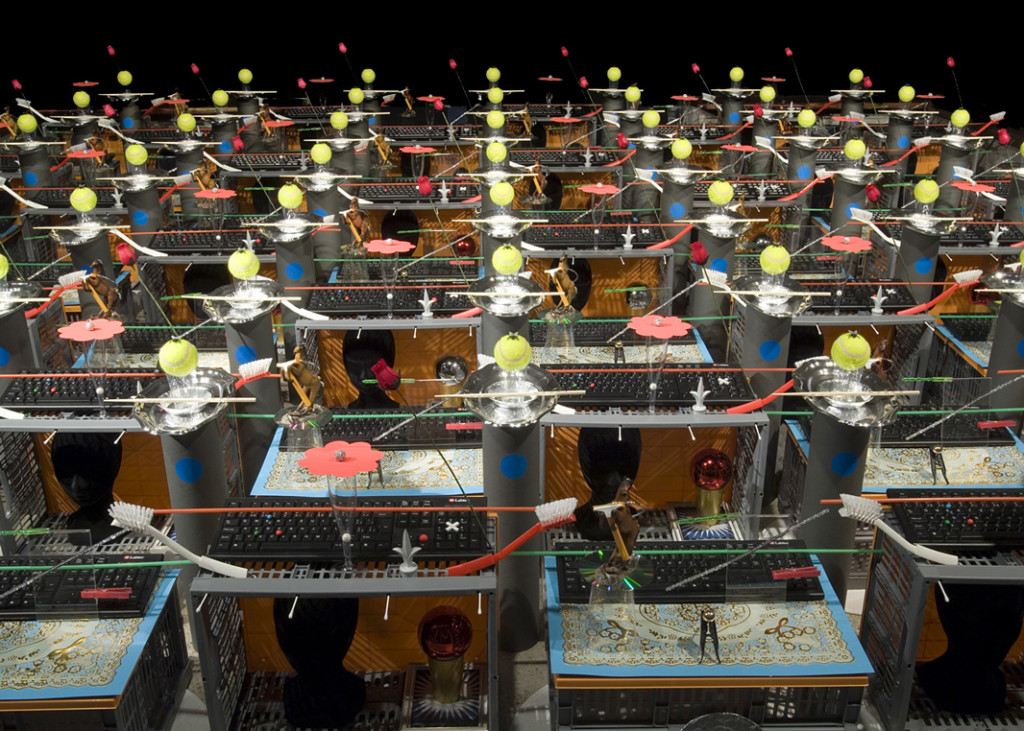
grey zone pattern, 2007 – installation, sundry objects – app. 480 x 480 cm. | Fondation Salomon art contemporain (photo: m. domage)
* * *
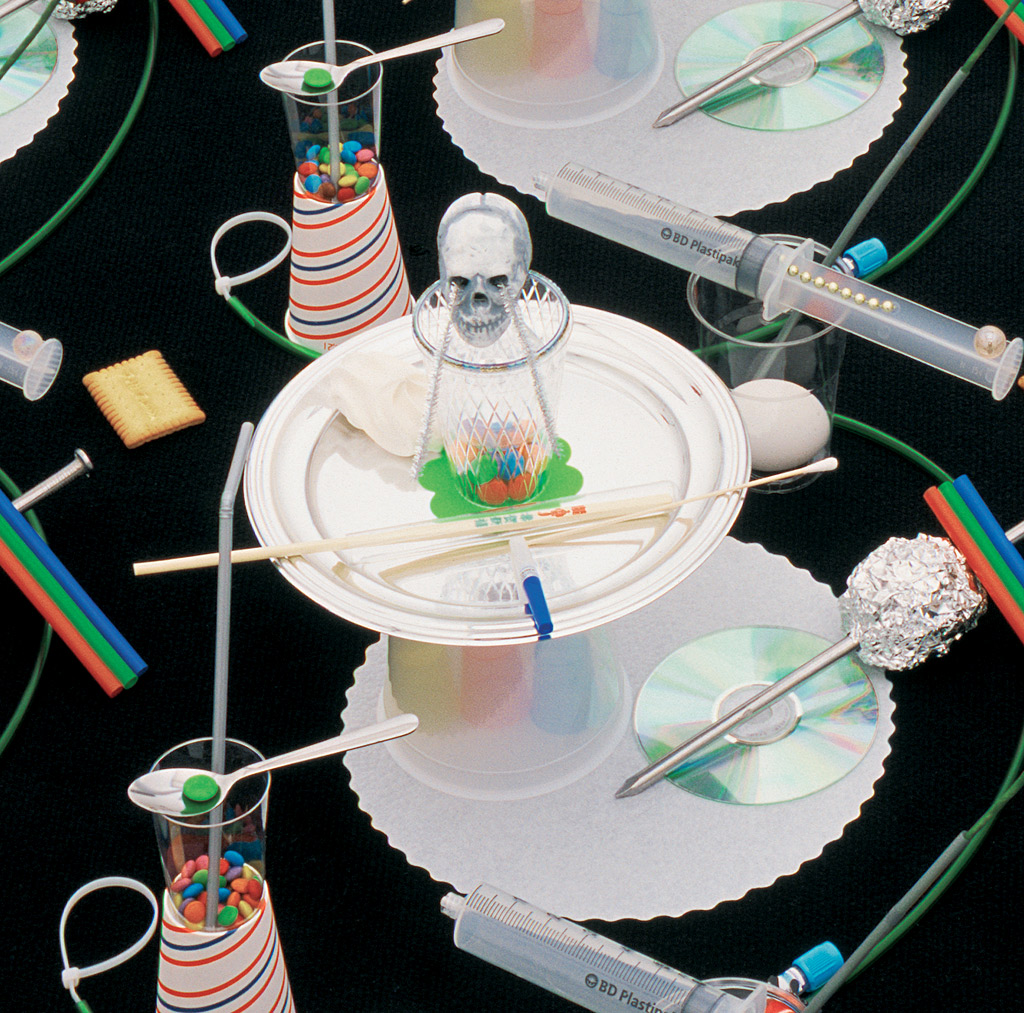
Pattern – Vanité 2b, 2003 – (detail)
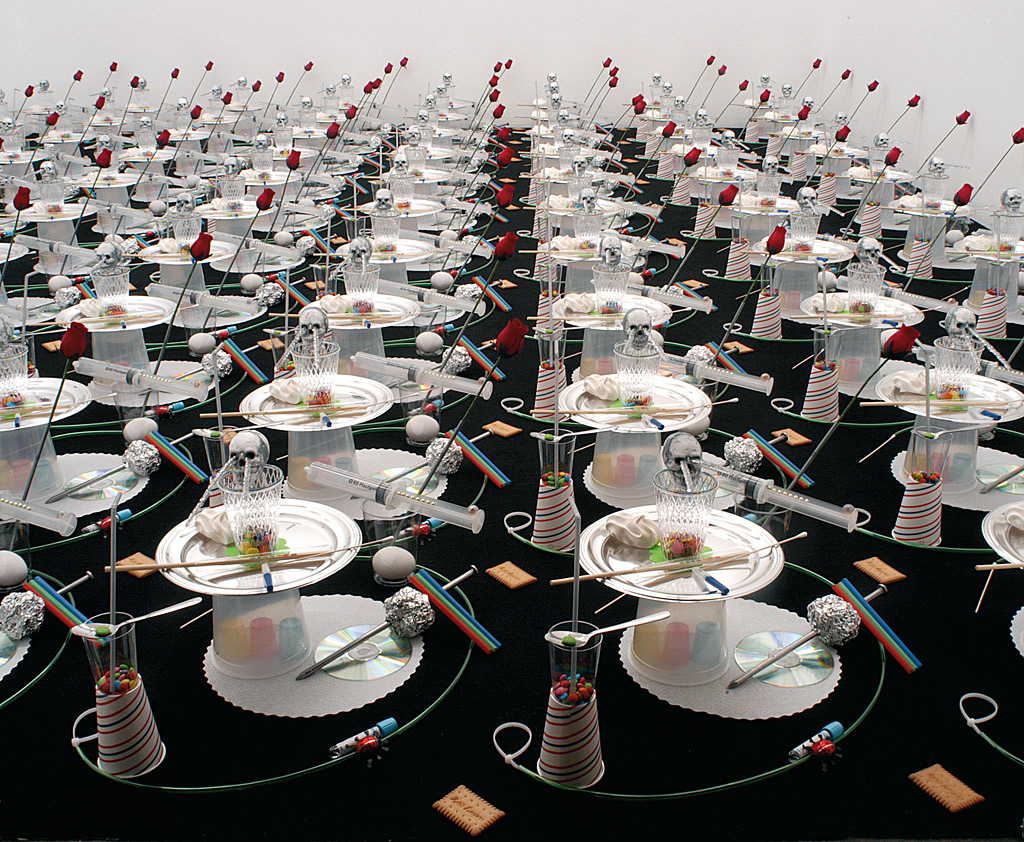
pattern vanité 2b, 2003 – installation, sundry objects – 400 x 500 cm.

Pattern – Vanité 2b, 2003 – installation, objets divers / installation, sundry objects – 400 x 500 cm. – installation view, mamco geneva
* * *
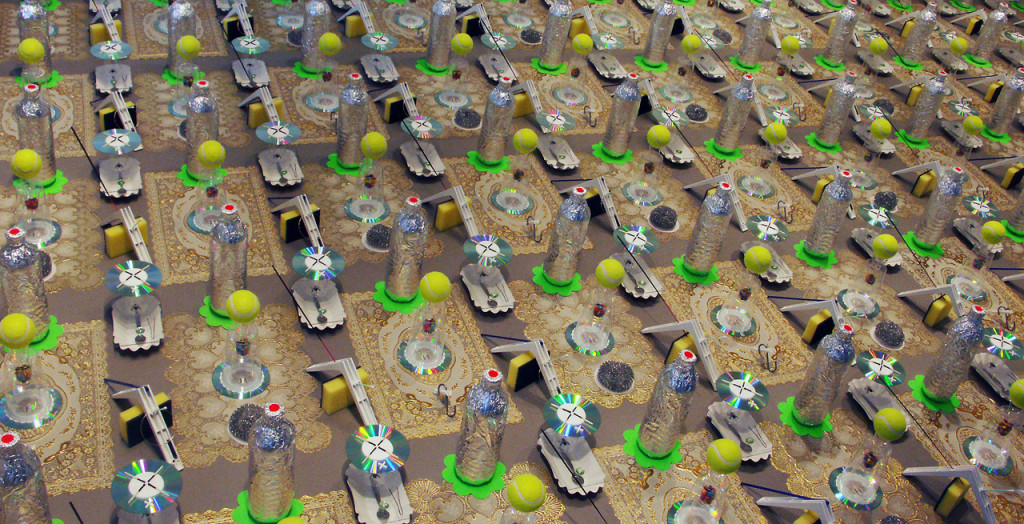
oriental gold pattern, 2006 – installation, sundry objects – appr. 350 x 800 cm. (exhibition view villa Oppenheim, Berlin)
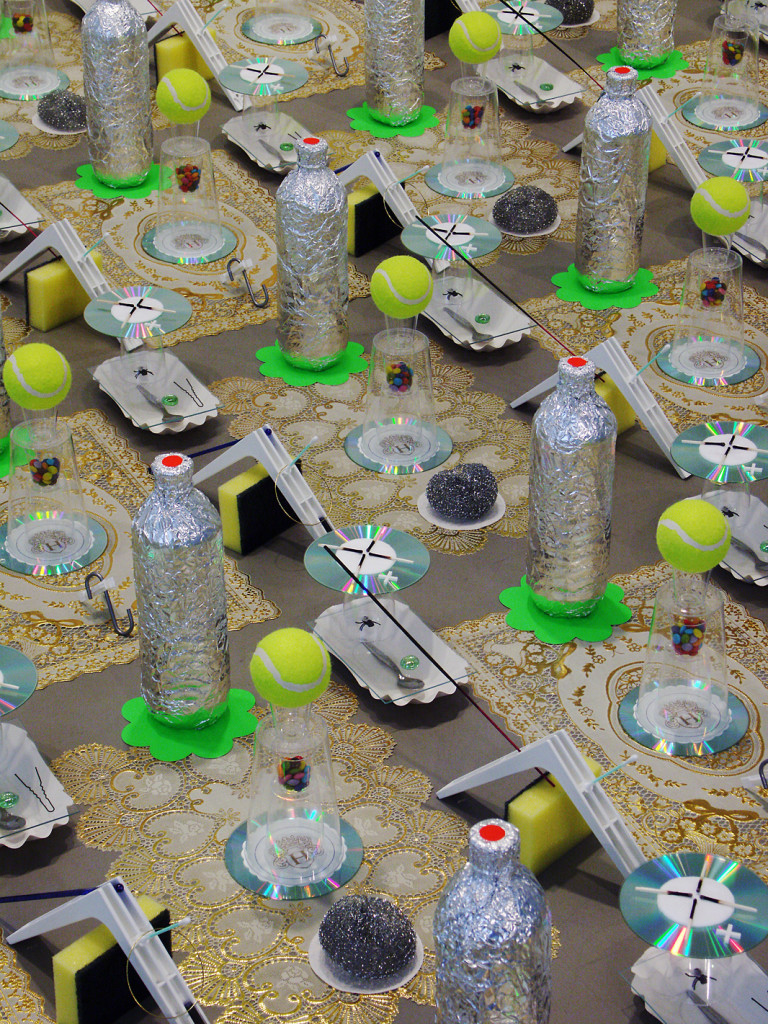
oriental gold pattern, 2006 – (detail)
* * *
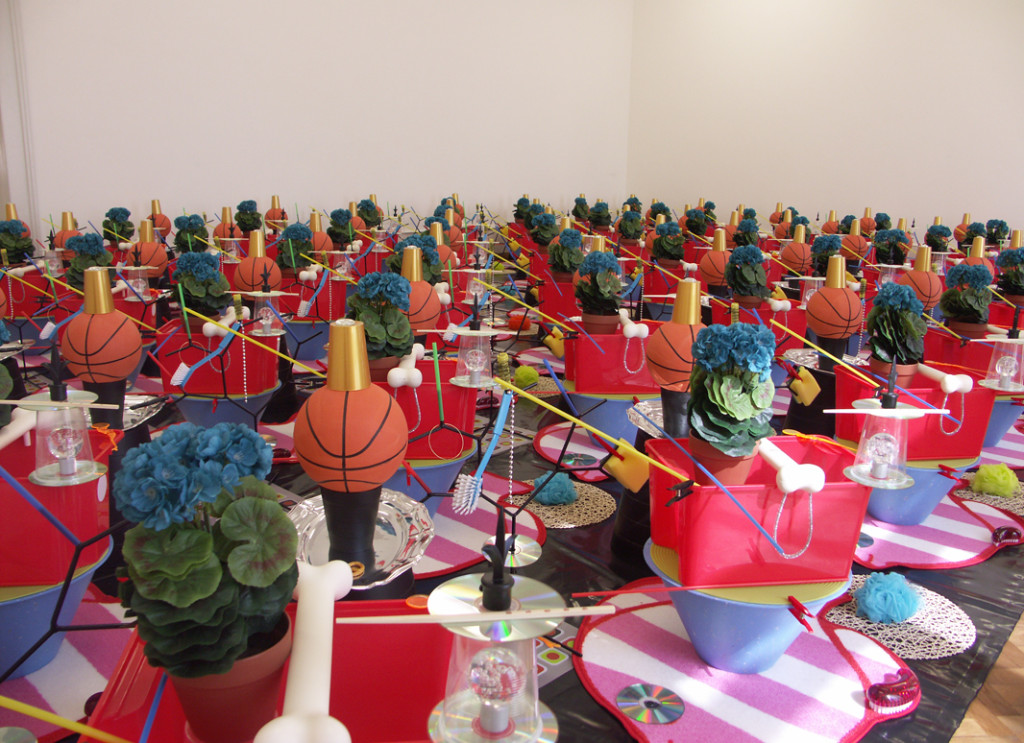
fish & bone w. emerald flower, 2007 – installation, sundry objects – appr. 600 x 900 cm. (exhibition view centre pasquart, Bienne)
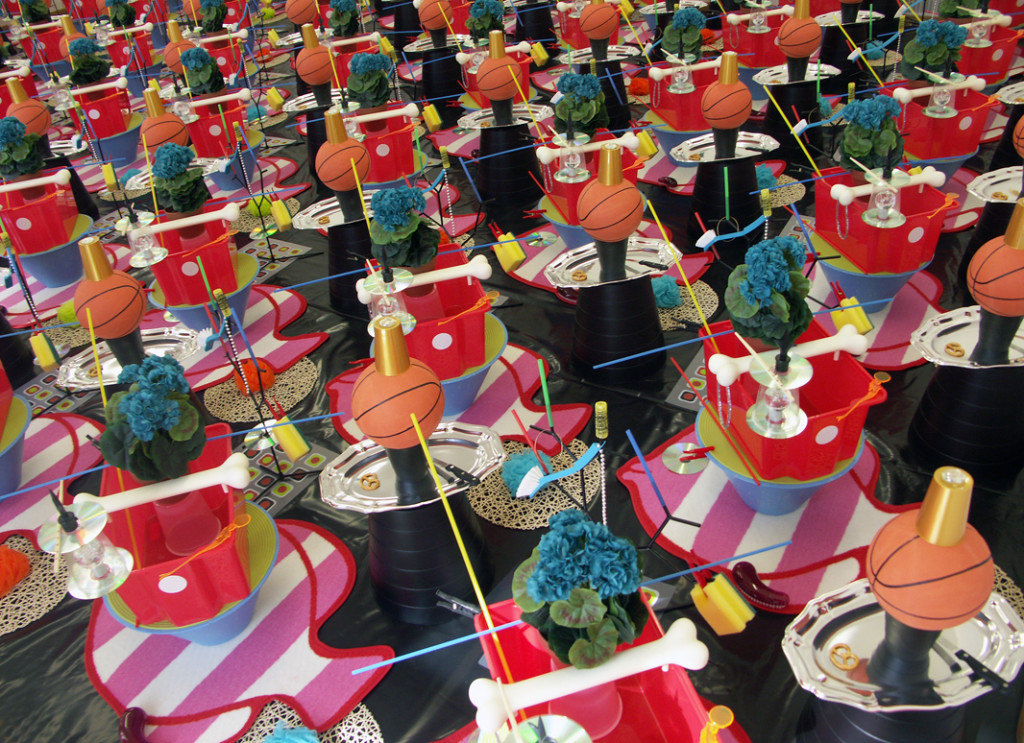
fish & bone w. emerald flower, 2007 – installation, sundry objects – appr. 600 x 900 cm.
* * *
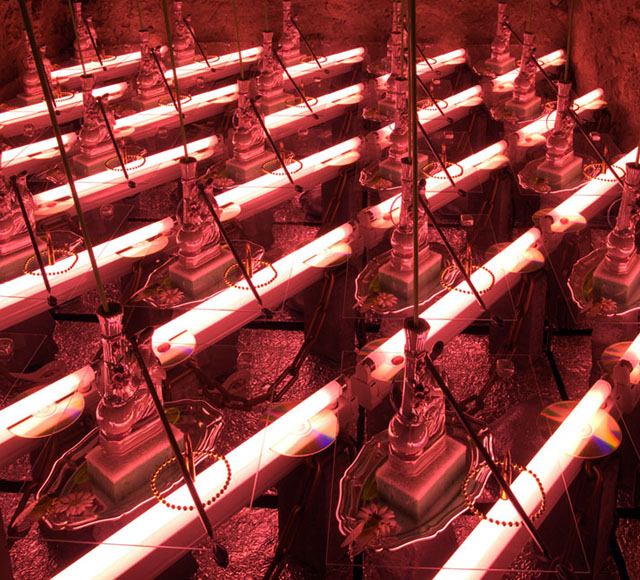
encrypted rosa pattern, 2005 – installation, sundry objects – 230 x 250 cm. (coll. Fondation Salomon art contemporain)
* * *
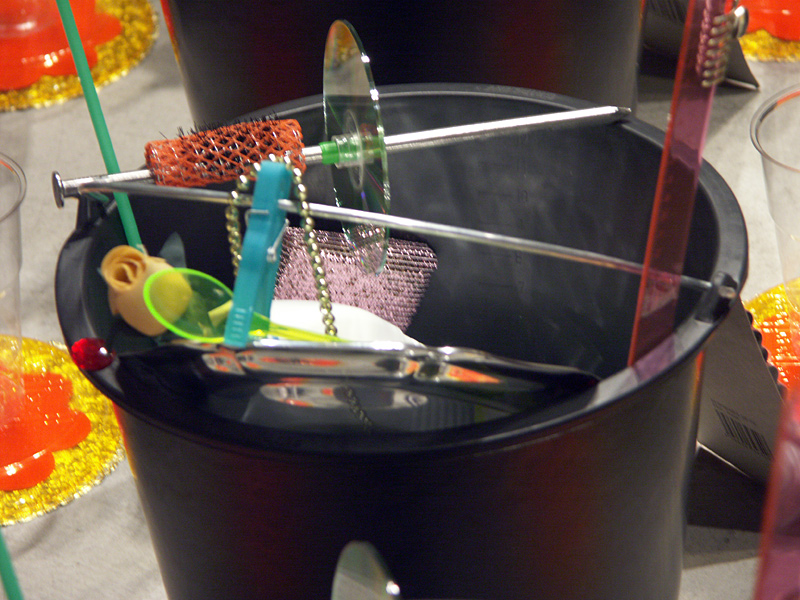
synth field pattern, 2005 – (detail)
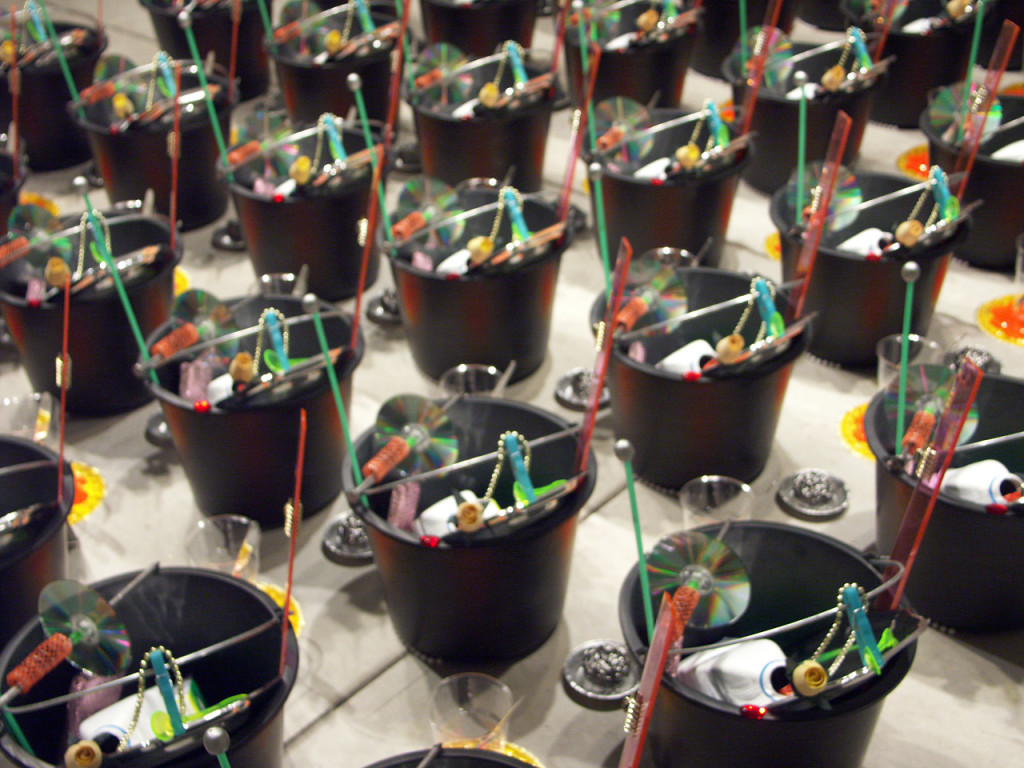
synth field pattern, 2005 – installation, sundry objects – appr. 400 x 400 cm.
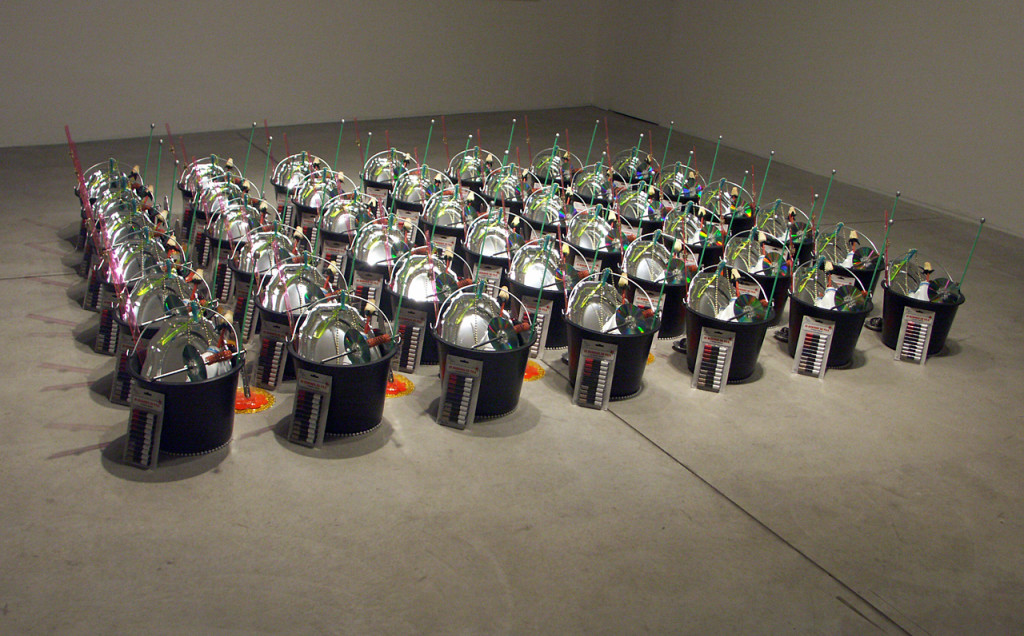
synth field pattern, 2005 – installation, sundry objects – appr. 400 x 400 cm. (exhibition view gallery 1000eventi, milano)
* * *

India Jamaica mix pattern, 2007 – installation, sundry objects – appr. 600 x 900 cm. (exhibition view centre pasquart, Bienne)
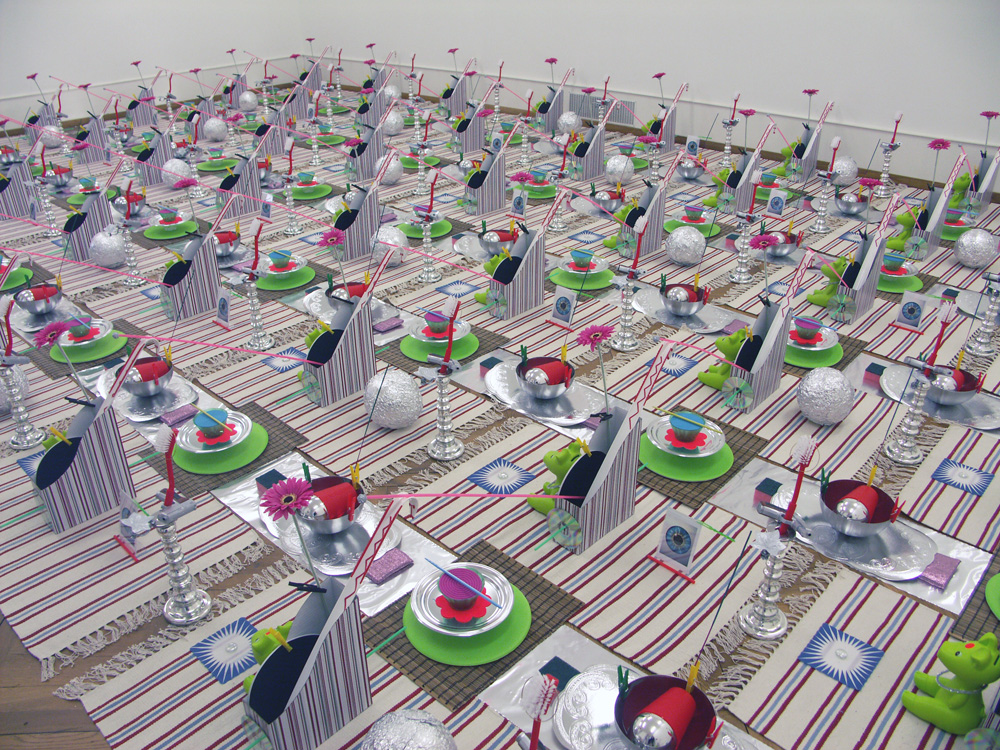
India Jamaica mix pattern, 2007 – installation, sundry objects – appr. 600 x 900 cm.
* * *
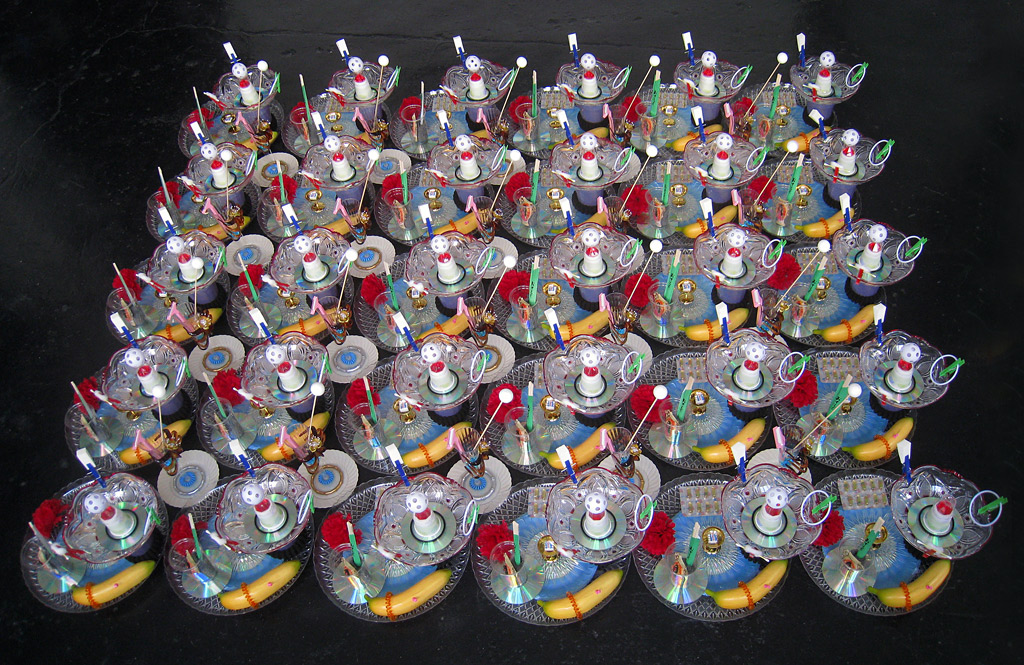
garbage chic L.A. pattern, 2010 – installation, sundry objects – appr. 220 x 200 cm.

garbage chic L.A. pattern, 2010 – installation, sundry objects – appr. 220 x 200 cm.
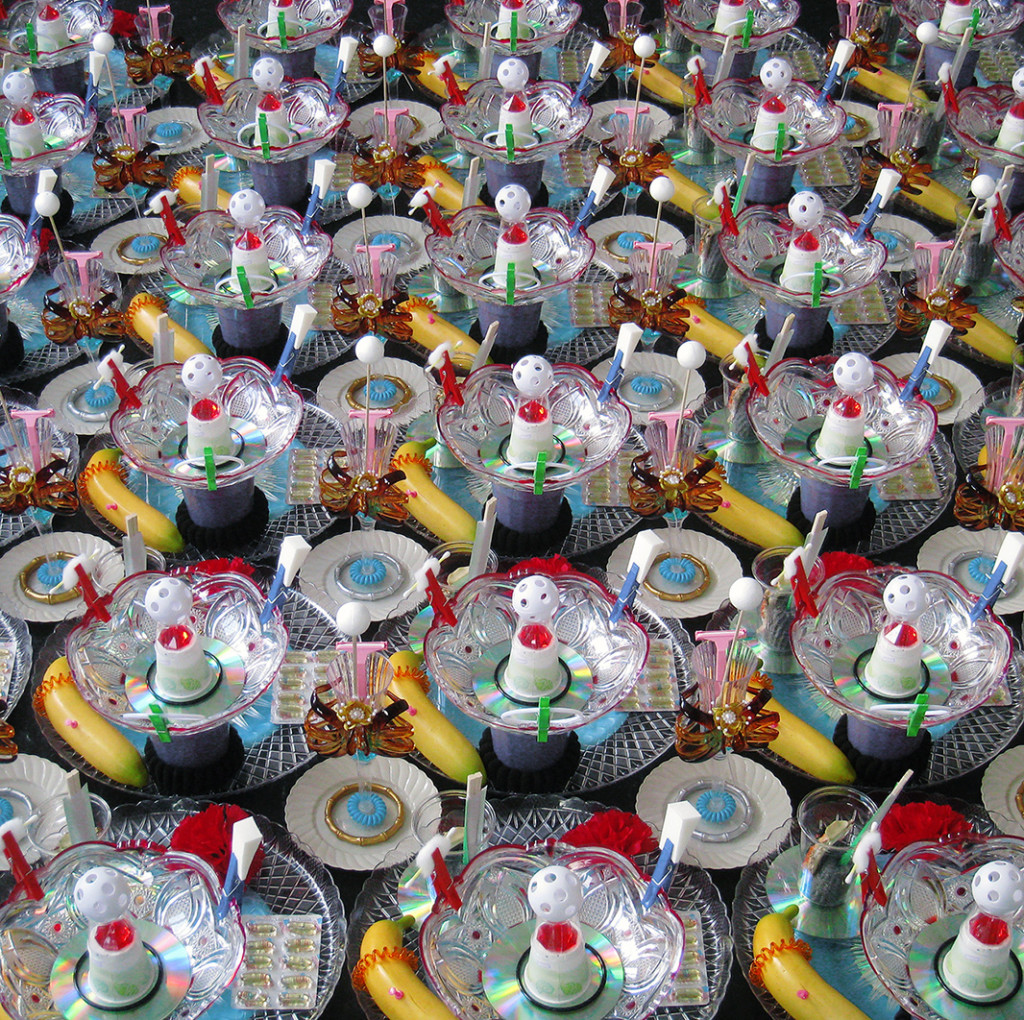
garbage chic L.A. pattern, 2010 – installation, sundry objects – appr. 220 x 200 cm. (CompactSpace Los Angeles)
* * *
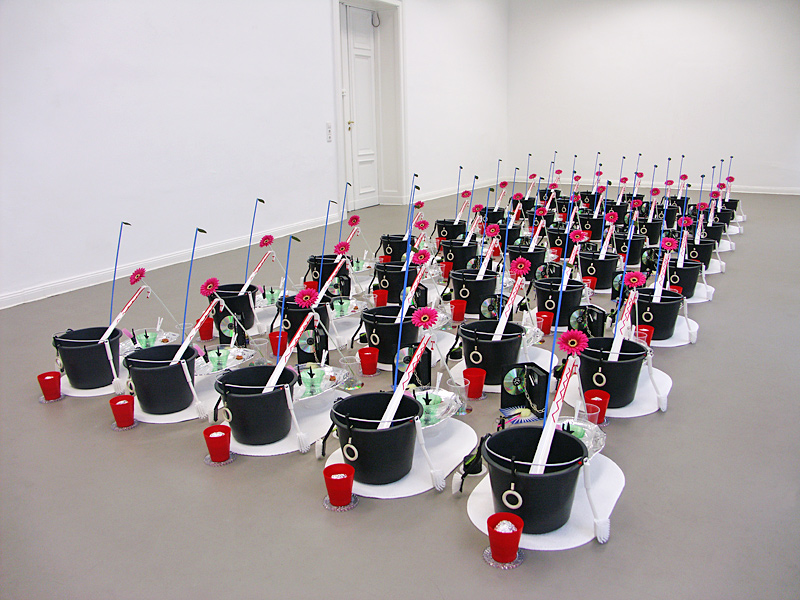
b. rhythmaschine pattern, 2006 – installation, sundry objects – 280 x 775 cm. (exhibition view villa Oppenheim, Berlin)
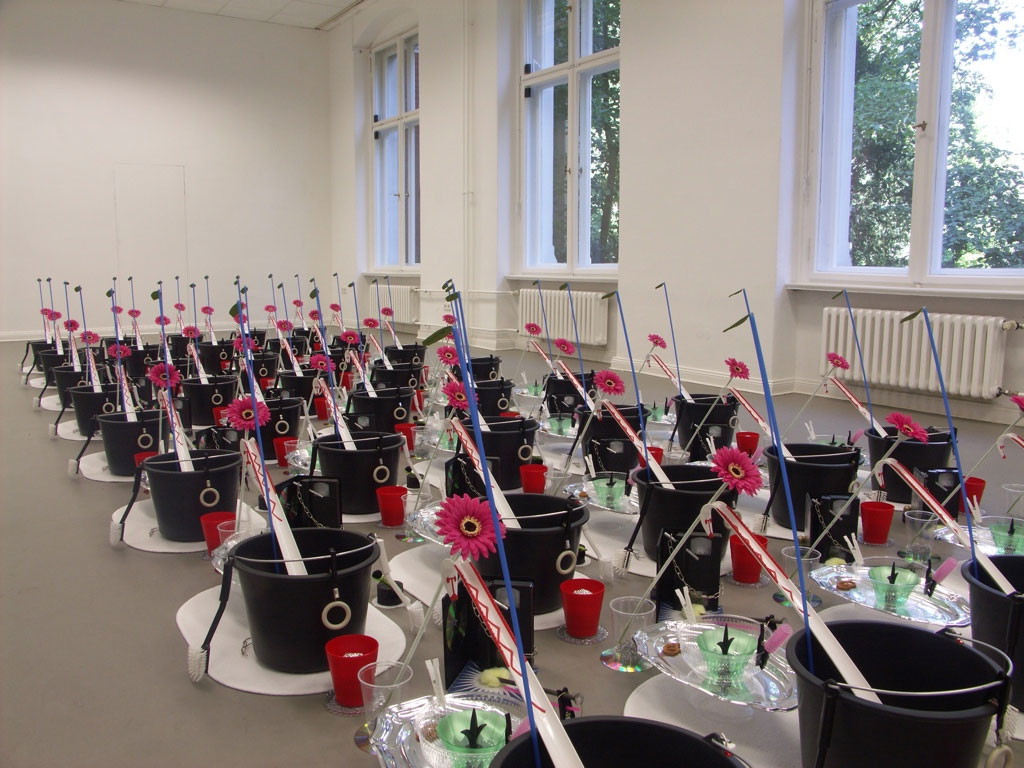
b. rhythmaschine pattern, 2006 – installation, sundry objects – 280 x 775 cm.
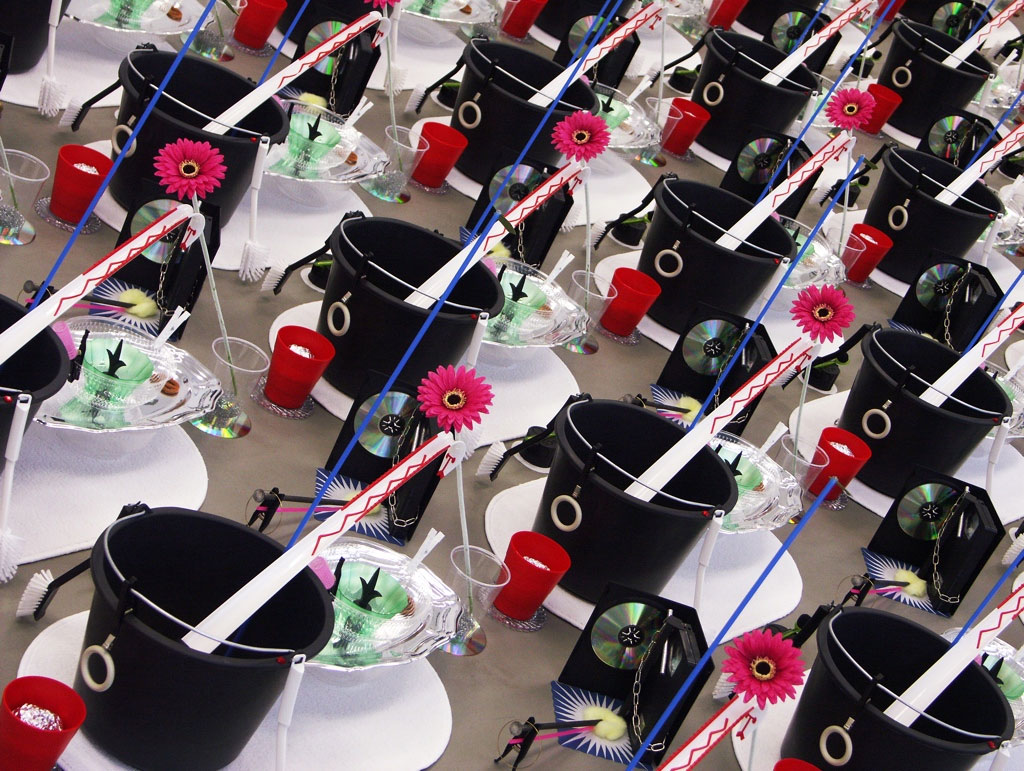
b. rhythmaschine pattern, 2006 – installation, sundry objects – 280 x 775 cm.
Patterns links / Vertical / Photographs
